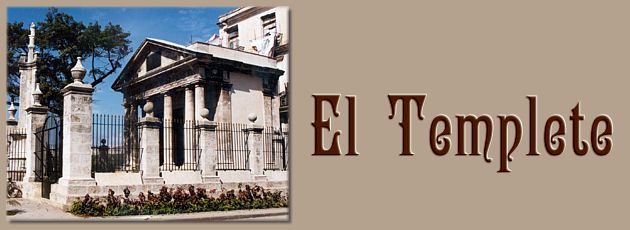
El primer Centenario del Templete
Mario Lescano Abella
MCCMXXVIII MCMXXVIII
(fragmento)
La ceiba memorable
Fundación de la ciudad de la Habana – La primera misa y el primer cabildo se celebran a la sombra de una frondosa ceiba. – Lo que cuenta la tradición. – Reparos de la crítica histórica. – Se esteriliza el árbol legendario. – Cargos contra el gobernador Cagigal. – La erección de una pilastra conmemorativa.
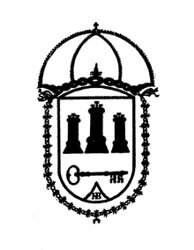 Esta nuestra ciudad de San Cristóbal de la Habana – que es hoy la alegre y cosmopolita capital de la República – fue fundada por Diego Velázquez el día 25 de julio de 1515, festividad de San Cristóbal, en la costa Sur de la Isla de Cuba, cerca de la boca del río Onicajinal, que desagua en la ensenada de Batabanó. A fines del año siguiente se le trasladó a la costa Norte, junto al puerto que Sebastián de Ocampo hubo de denominar Carenas, cuando fondeó y carenó en él sus dos frágiles y gallardas carabelas.
Esta nuestra ciudad de San Cristóbal de la Habana – que es hoy la alegre y cosmopolita capital de la República – fue fundada por Diego Velázquez el día 25 de julio de 1515, festividad de San Cristóbal, en la costa Sur de la Isla de Cuba, cerca de la boca del río Onicajinal, que desagua en la ensenada de Batabanó. A fines del año siguiente se le trasladó a la costa Norte, junto al puerto que Sebastián de Ocampo hubo de denominar Carenas, cuando fondeó y carenó en él sus dos frágiles y gallardas carabelas.
A poco de fundada se la dotó de un Ayuntamiento, colocándosela bajo el mando de un delegado de Velázquez, Pedro Barba, que ostentaba el título de teniente-a-guerra. Y asegura la tradición, con todos sus prestigios venerables, que junto al puerto, a la sombra de una hermosa ceiba, se dijo la primera misa y se celebró el primer cabildo. La crítica histórica, a este respecto, se muestra llena de reparos. Cronista ha habido – nos referimos al erudito Dr. Manuel Pérez Beato – que luego de negar el hecho, consigna este otro extremo: “Allí sí hubo una ceiba pero la cual en vez de veneración, le guardarían horror los vecinos de la villa porque en ella se azotaban a los que caían en pena por alguna causa, como evidencia el acta municipal de 8 de febrero de 1556”. (Inscripciones cubanas de los siglos XVI, XVII y XVIII. – Habana. – 1915.) A la postre la afirmación habría que probarla cumplidamente para no destruir, sin embargo, el bello y amable recuerdo; que no basta negar las leyendas para condenarlas a muerte. La historia sería un libro muy árido, sin ese gran poeta que es el pueblo y se encarga, a cada paso, de adornarla con remembranzas más o menos ciertas, pero casi siempre felices.
La ceiba precolombina, desafiando el furor de los huracanes tropicales y resistiendo a la hostil impiedad de los hombres,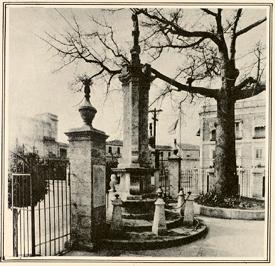 pudo conservarse hasta el año 1753 en que, gobernando la isla el capitán Francisco Cagigal de la Vega, ordenó fuera reemplazada por un pobre monumento en forma de pilastra triangular, de nueve varas de alto. La simbólica ceiba había desaparecido. ¿Cómo? Afirman unos que se esterilizó por vieja o maltratada. Otros acusan al gobernador Cagigal de su destrucción. Llegó a decirse que el Virrey, enojado porque el árbol le impedía contemplar el panorama del puerto y el arribo de los bajeles españoles, fue su verdugo y por su orden hacha vulgar le derribó en tierra. Aseguróse, también, que el representante de la Gran Bretaña en la Habana – a lo que parece el único que en aquellos días sospechaba el valor del árbol – adquirió un pedazo con destino al Museo Británico; y que el resto, comprado como leña por anónimos industriales, fue quizá a alimentar los hornos de los panaderos de entonces para cocer el pan destinado al impío vecindario de la ciudad.
pudo conservarse hasta el año 1753 en que, gobernando la isla el capitán Francisco Cagigal de la Vega, ordenó fuera reemplazada por un pobre monumento en forma de pilastra triangular, de nueve varas de alto. La simbólica ceiba había desaparecido. ¿Cómo? Afirman unos que se esterilizó por vieja o maltratada. Otros acusan al gobernador Cagigal de su destrucción. Llegó a decirse que el Virrey, enojado porque el árbol le impedía contemplar el panorama del puerto y el arribo de los bajeles españoles, fue su verdugo y por su orden hacha vulgar le derribó en tierra. Aseguróse, también, que el representante de la Gran Bretaña en la Habana – a lo que parece el único que en aquellos días sospechaba el valor del árbol – adquirió un pedazo con destino al Museo Británico; y que el resto, comprado como leña por anónimos industriales, fue quizá a alimentar los hornos de los panaderos de entonces para cocer el pan destinado al impío vecindario de la ciudad.
[…..]
En nuestros días ha defendido la memoria de Cagigal de aquel atentado, el Dr. Eugenio Sánchez de Fuentes en su libro “Cuba monumental, estatuaria y epigráfica” (Habana, 1916) sosteniendo la opinión de que el árbol fue derribado por un huracán o se esterilizó a consecuencia de los trabajos realizados, cerca de él, para la erección de la pilastra. “¿Cómo es posible asegurar – arguye – que Cagigal de la Vega, por la satisfacción de un mero capricho personal, inocente inclusive, desoyera la voz serena de la razón y realizara semejante atentado a la historia patria, prescindiendo no ya de nuestro ayuntamiento, representación legítima de la ciudad, que de seguro al conocer su propósito, se hubiera realmente opuesto, así como su procurador el ilustre don Manuel Felipe de Arango; sino de justísimos cargos que contra él, todo nuestro pueblo, hubiera formulado cívicamente, por tan bárbaro proceder? Además, es cosa averiguada, con absoluta certeza, que poco tiempo después de la erección del obelisco, tres nuevas ceibas fueron sembradas. Y a la verdad, la lógica inflexible de los hechos, nos hace deducir que el supuesto sacrificio de la precolombina, resultó completamente inútil toda vez que con la columna y el sembrado de los nuevos árboles, el campo de la visualidad quedó mucho más limitado que antes.”
[…..]
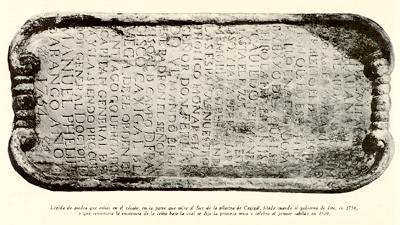 La inculpación hecha al gobernador Cagigal no tiene ningún fundamento sólido. Lo de la adquisición por un cónsul extranjero, de un fragmento de la ceiba derribada, se registra en algunos papeles viejos. Por ejemplo, el doctor Domingo Rosain en su extraño libro “Necrópolis de la Habana. – Historia de los cementerios de esta ciudad” (Habana 1875) manifiesta: “En 1753 derribada la que existía (la ceiba) sus fragmentos se vendieron para leña, comprando algunos el cónsul de los Estados Unidos para el Museo de Washington”. ¡El cronista olvida que hasta 1783 dominó Inglaterra en la América del Norte!
La inculpación hecha al gobernador Cagigal no tiene ningún fundamento sólido. Lo de la adquisición por un cónsul extranjero, de un fragmento de la ceiba derribada, se registra en algunos papeles viejos. Por ejemplo, el doctor Domingo Rosain en su extraño libro “Necrópolis de la Habana. – Historia de los cementerios de esta ciudad” (Habana 1875) manifiesta: “En 1753 derribada la que existía (la ceiba) sus fragmentos se vendieron para leña, comprando algunos el cónsul de los Estados Unidos para el Museo de Washington”. ¡El cronista olvida que hasta 1783 dominó Inglaterra en la América del Norte!
En la pilastra, sobre la lápida del zócalo, en la parte que mira al Sur, se fijó la siguiente inscripción: “FUNDOSE LA VILLA (OY CIUDAD) DE LA HAVANA A LA RIVERA DE ESE PUERTO EL DE 1519. ES TRADICION QUE EN ESTE SITIO SE HALLO UNA FRONDOSA SEIBA BAXO DE LA CUAL SE CELEBRO LA PRIMERA MISSA Y CAVILDO: PERMANECIO HASTA EL DE 1753 QUE SE ESTERILISO; Y PARA PERPETUAR LA MEMORIA GOBERNANDO LAS ESPAÑAS NUESTRO CATHOLICO MONARCHA EL SEÑOR DON FERNANDO VI MANDO EREGIR ESTE PADRON EL SEÑOR MARISCAL DE CAMPO DON FRANCISCO CAXIGAL DE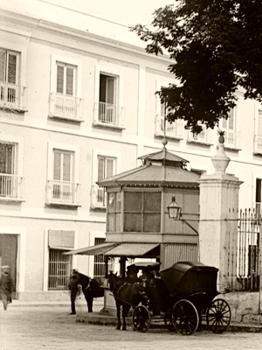 LA VEGA DE EL ORDEN DE SANTIAGO GOBERNADOR Y CAPITAN GENERAL DE ESTA YSLA: SIENDO PROCURADOR GENERAL DOCTOR DON MANUEL PHELIPE DE ARANGO AÑO DE 1 7 5 4
LA VEGA DE EL ORDEN DE SANTIAGO GOBERNADOR Y CAPITAN GENERAL DE ESTA YSLA: SIENDO PROCURADOR GENERAL DOCTOR DON MANUEL PHELIPE DE ARANGO AÑO DE 1 7 5 4
En la cara de la base del pilar que mira al Norte se grabó, según Pezuela, esta otra leyenda:
SISTE GRADUM VIATOR ORNAT HUNC LOCUM ARBOS CEIBA FRONDOSA POTIUS DIXERIM PRIMEVAE CIVI TATIS PRUDENTIAE RELIGIONIS PRIMEVAE MEMORABILE SIGNUM: SIQUI DEM EJUS SUB UMBRA APRIME HAC IN URBE INMOLATUS SALUTIS AUTOR. HABITUS PRIMO PRUDENTUM DECURIONUM SENATUS DUOBUS PLUS AB IN SAECULIS PERPETUA TRADITIONE HABEBATUR. CESSIT TAMEN AETATI. INTUERE IGITUR, ET NE PAREAT IN POSTERUM HABANENSEM FIDEM. ASPICIES IMAGINEM SUPRA PETRAM FUNDATAN HODIE NIMIRUM ULT. MENSIS NOVEMBRIS ANNO MDCCLIV.
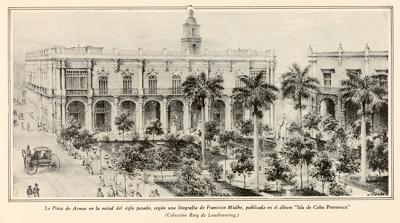 La traducción la ha dado el doctor Juan Miguel Dihigo, latinista y catedrático de Nuestra Universidad, que le hizo a la leyenda ciertas modificaciones de las que luego nos ocuparemos. Dice así en castellano: “Detén el paso caminante, adorna este sitio un árbol, una ceiba frondosa, más bien diré signo memorable de la prudencia y antigua religión de la joven ciudad, pues ciertamente bajo su sombra fue inmolado solemnemente en esta ciudad el autor de la salud. Fue tenida por primera vez la reunión de los prudentes concejales hace ya más de dos siglos: era conservado por una tradición perpetua; sin embargo cedió al tiempo. Mira pues y no perezca en lo porvenir la fe habanera. Verás una imagen hecha hoy en la piedra, es decir el último de Noviembre en el año 1754.”
La traducción la ha dado el doctor Juan Miguel Dihigo, latinista y catedrático de Nuestra Universidad, que le hizo a la leyenda ciertas modificaciones de las que luego nos ocuparemos. Dice así en castellano: “Detén el paso caminante, adorna este sitio un árbol, una ceiba frondosa, más bien diré signo memorable de la prudencia y antigua religión de la joven ciudad, pues ciertamente bajo su sombra fue inmolado solemnemente en esta ciudad el autor de la salud. Fue tenida por primera vez la reunión de los prudentes concejales hace ya más de dos siglos: era conservado por una tradición perpetua; sin embargo cedió al tiempo. Mira pues y no perezca en lo porvenir la fe habanera. Verás una imagen hecha hoy en la piedra, es decir el último de Noviembre en el año 1754.”
Como elementos decorativos de la pilastra figuraban, en el primer frente del triángulo que mira al naciente, un relieve del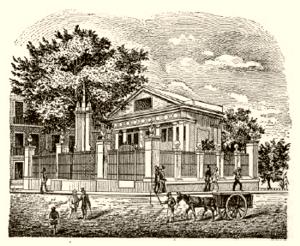 tronco de la primitiva ceiba, seca, con las ramas cortadas y sin follaje alguno; en lo cimero, como para que protegiese la ciudad, una imagen de Nuestra Señora del Pilar, de construcción gótica como apunta un documento oficial de a principios del pasado siglo.
tronco de la primitiva ceiba, seca, con las ramas cortadas y sin follaje alguno; en lo cimero, como para que protegiese la ciudad, una imagen de Nuestra Señora del Pilar, de construcción gótica como apunta un documento oficial de a principios del pasado siglo.
No bastó a los habaneros de entonces el testimonio de la piedra. Parece que  el recuerdo de la dulce ceiba legendaria les preocupaba. Lo cierto es que unos años más tarde – entre 1755 y 1757, según Sánchez de Fuentes – el Ayuntamiento acordó plantar tres ceibas alrededor del monumento. Dos de ellas perecieron al poco tiempo. La que sobrevivió fue víctima, en 1827, de un crimen que, sin embargo, no alarmó a nadie. ¡Y el señor Sánchez de Fuentes que cree que la ciudad se hubiera cívica e inteligentemente opuesto al deseo de Cagigal, caso que este hubiese ordenado, por razones visuales o de otra especie, el derribo del árbol venerable que cobijó a Diego Velázquez y a sus valientes! En 1827, cuando se llevaba a cabo la construcción del Templete, el Cabildo acordó derribar esa ceiba, castigándola por bella y por frondosa. Se estimó que sus fuertes y hondas raíces podían poner en peligro la solidez de la nueva construcción. El hacha municipal consumó su obra con aplausos. Al terminarse el Templete, en el año siguiente, el Ayuntamiento dio órdenes para que se sembrasen nuevos árboles: ceibas, álamos, palmas. El capitán Andrés de Acosta los trajo de una finca denominada “María de Ayala”, precisamente donde está enclavado hoy el barrio de Luyanó. La que existe es una de esas ceibas que, esbelta e impávida, ha resistido a los sucesos alegres y tristes, grandes y pequeños. Otras, que se sembraron en 1873, tuvieron efímera vida: dos lustros, que nada son si se tiene en cuenta que estos gigantes contemplan el paso de los siglos.
el recuerdo de la dulce ceiba legendaria les preocupaba. Lo cierto es que unos años más tarde – entre 1755 y 1757, según Sánchez de Fuentes – el Ayuntamiento acordó plantar tres ceibas alrededor del monumento. Dos de ellas perecieron al poco tiempo. La que sobrevivió fue víctima, en 1827, de un crimen que, sin embargo, no alarmó a nadie. ¡Y el señor Sánchez de Fuentes que cree que la ciudad se hubiera cívica e inteligentemente opuesto al deseo de Cagigal, caso que este hubiese ordenado, por razones visuales o de otra especie, el derribo del árbol venerable que cobijó a Diego Velázquez y a sus valientes! En 1827, cuando se llevaba a cabo la construcción del Templete, el Cabildo acordó derribar esa ceiba, castigándola por bella y por frondosa. Se estimó que sus fuertes y hondas raíces podían poner en peligro la solidez de la nueva construcción. El hacha municipal consumó su obra con aplausos. Al terminarse el Templete, en el año siguiente, el Ayuntamiento dio órdenes para que se sembrasen nuevos árboles: ceibas, álamos, palmas. El capitán Andrés de Acosta los trajo de una finca denominada “María de Ayala”, precisamente donde está enclavado hoy el barrio de Luyanó. La que existe es una de esas ceibas que, esbelta e impávida, ha resistido a los sucesos alegres y tristes, grandes y pequeños. Otras, que se sembraron en 1873, tuvieron efímera vida: dos lustros, que nada son si se tiene en cuenta que estos gigantes contemplan el paso de los siglos.
La Habana: Sindicato de Artes Gráficas, 1928
Doña Lola, idealista y ambiciosa, nos decía que el pájaro caribeño somos las dos alas. En estos días, cuando tenemos que recoger alas, quizá nos valga más la pena ir de lo más pequeño para llegar a esa totalidad. Por eso digo que tú y yo somos las dichosas alas, y así lo digo para que poco a poco lleguemos a alcanzar lo que Doña Lola quería. Le doy tres vueltas a la ceiba para que así sea. Acompáñame.
Efraín Barradas
Con una invitación así, y con la promesa de reencontrar tantos amigos en el tiempo, ¿cómo faltar a la cita de Iroko, la Espaciosa, la Madre? "El Monte tiene su ley", nos enseñó Lydia Cabrera. Gracias a La Habana Elegante por recordarnos a sus hijas e hijos que debemos cumplir el mandato de su árbol sagrado.
Madelín Cámara
Un Monumento y una Sugestiva Ceiba
María Teresa Villaverde Trujillo
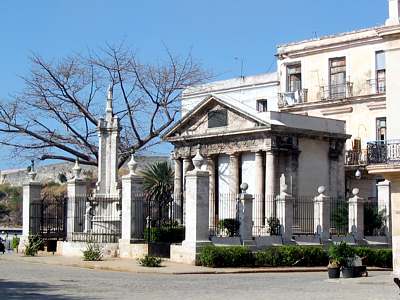 Cada 15 de noviembre, hacia la medianoche, visitamos el monumento El Templete y su Ceiba para festejar otro aniversario de la fundación de San Cristóbal de La Habana, hecho histórico realizado en 1519 por el conquistador español y gobernador de la isla Diego Velázquez de Cuéllar. El nombre de la entonces villa, asignada asi por el lugarteniente del gobernador general Pánfilo de Narváez surgió de la unión del nombre del santo patrón y del nombre de un cacique taino de aquella área. También, los que hemos vivido cerca de la Ceiba sabemos lo difícil que es olvidar este árbol, representativo del nacimiento de mi ciudad natal, centro de las actividades en la época colonial.
Cada 15 de noviembre, hacia la medianoche, visitamos el monumento El Templete y su Ceiba para festejar otro aniversario de la fundación de San Cristóbal de La Habana, hecho histórico realizado en 1519 por el conquistador español y gobernador de la isla Diego Velázquez de Cuéllar. El nombre de la entonces villa, asignada asi por el lugarteniente del gobernador general Pánfilo de Narváez surgió de la unión del nombre del santo patrón y del nombre de un cacique taino de aquella área. También, los que hemos vivido cerca de la Ceiba sabemos lo difícil que es olvidar este árbol, representativo del nacimiento de mi ciudad natal, centro de las actividades en la época colonial.
Por mandato de los reyes durante el siglo XVII se nombró a La Habana "Llave del Nuevo Mundo y antemural de las Indias”
El Templete fue construido a principio del siglo XIX, en el mismo sitio donde celebraron al pie de una Ceiba la primera misa y la reunión del primer cabildo presidido por Diego Velázquez de Cuéllar, - entonces Teniente Gobernador de la isla-, en la costa norte de La Habana en 1519. Fue una obra del coronel de ingenieros el cubano Antonio María de la Torre y Cardenas bajo los auspicios del capitán general y gobernador Francisco Dionisio Vives, y el obispo de La Habana Juan José Díaz de Espada y Fernández de Landa. El monumento adopta la forma de un singular templo dórico, sobre un cuadrilongo regular de treinta y 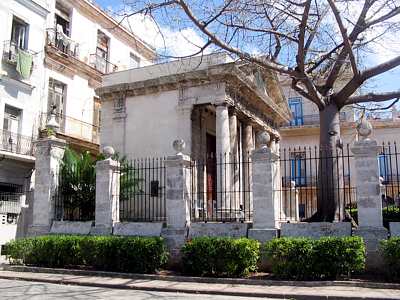 dos varas de este a oeste y de veintidós de norte a sur, cercado el monumento por una enverjadura de hierro que termina en lanzas de bronce, apoyadas sobre globos del mismo metal. Mide doce varas de frente y ocho y media por los dos costados así como 11 de alto, compuesto de un arquitrabe de seis columnas de capiteles dóricos y zócalos áticos y cuatro pilastras en los costados. La portada de hierro que pesa dos mil libras rueda sobre ejes de bronce, coronándose con un escudo de cinco pies de altura en cuya orla aparece la siguiente frase: “La siempre fidelísima ciudad de La Habana”.
dos varas de este a oeste y de veintidós de norte a sur, cercado el monumento por una enverjadura de hierro que termina en lanzas de bronce, apoyadas sobre globos del mismo metal. Mide doce varas de frente y ocho y media por los dos costados así como 11 de alto, compuesto de un arquitrabe de seis columnas de capiteles dóricos y zócalos áticos y cuatro pilastras en los costados. La portada de hierro que pesa dos mil libras rueda sobre ejes de bronce, coronándose con un escudo de cinco pies de altura en cuya orla aparece la siguiente frase: “La siempre fidelísima ciudad de La Habana”.
Las obras culminaron con su inauguración el 19 de marzo de 1828, en homenaje a Josefa Amalia de Sajonia, esposa de Fernando VII. Dos grandes lienzos adornaron su interior, uno representando la primera misa ofrecida por el Padre de Las Casas y el otro el primer cabildo, ambas obras del pintor frances Jean Baptiste Vermay.
Fuera de la edificación aparece un obelisco de tres caras, llamado Cajigal por ser el apellido del gobernador Francisco Cajigal de la Vega, quién ordenó construirla en 1754 cuando la Ceiba dejó de sostenerse en pie. La columna sostenía una imagen de Nuestra Señora del Pilar, patrona de los navegantes españoles. A la antigua imagen religiosa, sustituyó otra de la Virgen, de una vara de alto sobre un pilar de tres cuartas, en cuyo centro está trazada la Cruz de Aragón, con una inscripción que dice: “Memoria inmortal a Francisco Dionisio Vives y Planes, teniente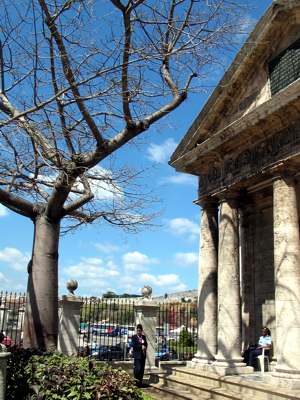 general de los Reales Ejércitos, benemérito de la patria. Año de mil ochocientos veintidós”.
general de los Reales Ejércitos, benemérito de la patria. Año de mil ochocientos veintidós”.
En su base se encuentra un busto de mármol del Adelantado Don Hernando de Soto, primer gobernador de la villa; y en ella hay una inscripción en latín, casi borrada, que traducida dice:
"Detén el paso, caminante, adorna este sitio un árbol, una ceiba frondosa, más bien diré signo memorable de la prudencia y antigua religión de la joven ciudad, pues ciertamente bajo su sombra fue inmolado solemnemente en esta ciudad el autor de la salud. Fue tenida por primera vez la reunión de los prudentes concejales hace ya más de dos siglos: era conservado por una tradición perpetua: sin embargo, cedió al tiempo. Verás una imagen hecha hoy en la piedra, es decir el último de noviembre en el año 1754"
Dentro de los límites del monumento, cerrado por las verjas que protegen el Templete, se localiza un busto de mármol de Cristóbal Colón; y se mantiene una frondosa Ceiba en medio del pequeño jardin. La original Ceiba fue destruida por un ciclon; mas tarde otra Ceiba regresó a su lugar y, según narraciones, al ésta secarse, una tercera es la que ocupa actualmente su destinado espacio. El pavimento de El Templete es de mármol blanco.
En el interior del Templete se encuentra un triptico - cuyo lienzo central fue pintado tiempo despues a la inauguración del monumento – representando la primera misa en el acto de bendición del lugar en presencia del Capitán General, el primer consejo de gobierno y la construccion del Templete, apareciendo en ellos las figuras de las autoridades españolas de la época. Es un histórico triptico que dejó para la posteridad unas excelentes estampas de coloridos acontecimientos.
Las fotos que acompañan este artículo nos fueron cedidas gentilmente por el prof. Paul Barret, de la Universidad de Texas, y no pueden reproducirse sin su consentimiento.
Noviembre de 2010
Querido Francisco:
Una vez más, un aniversario de nuestra querida Habana nos une. Te enviamos un abrazo y saludos a todos los que participamos en este ritual, justificado por nuestro cariño hacia nuestra maltratada ciudad. Y con aumentado cariño, otro abrazo para ti por regalarnos otra oportunidad de vernos todos otra vez al pie de la ceiba.
Aymara y Micael Avalos
Miami
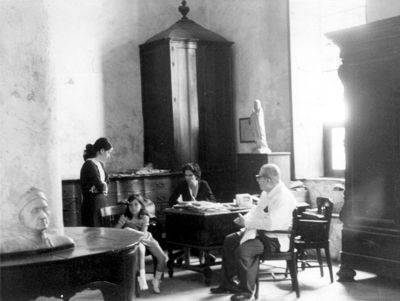 La foto es en la sacristía de la Iglesia del Espíritu Santo el 4 de marzo de 1976, en el bautizo de Ariadna Prats García. Al fondo aparece María Luisa Bautista; al frente hay un busto de Dante. Dante, Lezama, dos escritores que sufrieron el exilio; el cubano en su propia tierra, desde 1971 hasta su muerte. En este 491 aniversario de La Habana inmortal e inmoral, Lezama como autor de Muerte de Narciso y Virgilio Piñera, autor de La isla en peso, le dan la vuelta a la ceiba aciclonada de Oppiano Licario, se unen al fantasma de Hernando de Soto para repetir una frase escrita por Lezama en la primera carta a su hermana Eloísa (abril de 1961), a la que nunca volvería a ver: "Quiera Dios que se restablezca la armonía".
La foto es en la sacristía de la Iglesia del Espíritu Santo el 4 de marzo de 1976, en el bautizo de Ariadna Prats García. Al fondo aparece María Luisa Bautista; al frente hay un busto de Dante. Dante, Lezama, dos escritores que sufrieron el exilio; el cubano en su propia tierra, desde 1971 hasta su muerte. En este 491 aniversario de La Habana inmortal e inmoral, Lezama como autor de Muerte de Narciso y Virgilio Piñera, autor de La isla en peso, le dan la vuelta a la ceiba aciclonada de Oppiano Licario, se unen al fantasma de Hernando de Soto para repetir una frase escrita por Lezama en la primera carta a su hermana Eloísa (abril de 1961), a la que nunca volvería a ver: "Quiera Dios que se restablezca la armonía".
José Prats
Dejo junto a la ceiba fiel de La Habana Elegante, guardiana de la fe habanera, mis votos por la salvación de la ciudad, aunque solo sea en el daguerrotipo de la memoria.
Armando Sandoval
Estas páginas son un oasis de buen gusto y esmero. En este 491 Aniversario pediré en la ceiba un mejor destino para mi Patria, familiares y amigos.
Laureano
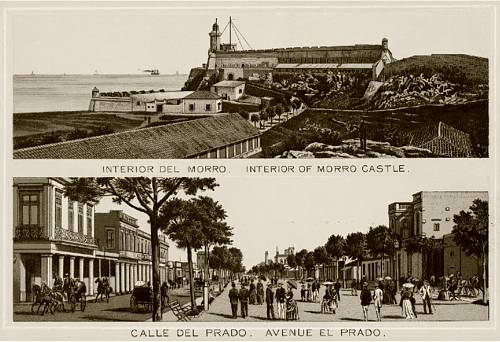
Directorio criticón de la Habana (1883)
Juan Franqueza
Fragmentos
La calle de la Muralla
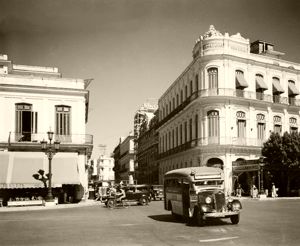 Estamos en la más célebre vía de la Habana. Su verdadero nombre es Ricla, que fue título condal de uno de los capitanes generales que gobernaron la isla; pero todo el mundo le dice de la Muralla y así tenemos que llamarla nosotros, poco afectos tambien a recordar magnates. No se explica cómo se hacen las cosas inmateriales tan respetables como las entidades humanas, y por qué un conjunto de piedras a los lados de una calle, imprimen respeto y toda clase de fenómenos mentales entre un pueblo despreocupado y casi transitorio como lo es el nuestro; mas es el caso que así sucede y que la calle de la Muralla es la entidad mas respetable e influyente de la capital de la Gran Antilla. Miles de individuos se han encumbrado, ya por medio del dinero ya por el de las letras o el de la milicia, y el tiempo los ha derribado luego como castillos de naipes, esparciendo sus recuerdos entre el polvo del olvido; pero la calle de la Muralla pasa de vicisitud en vicisitud, de tormenta en tormenta, y su tipo y su prestigio se mantienen intactos sin que haya ciclón que la melle, y antes al contrario, parece rejuvenecerse a cada desastre que conmueven los cimientos del comercio o de la sociedad. ¿En qué estriba este fenómeno? Probable es que nadie lo explique satisfactoriamente, porque el argumento de la aotigüedad lo destruyen algunos ejemplos de cosas viejas que cayeron ya desplomadas por el espíritu innovador del siglo. El caso es que los establecimientos de la calle de que venimos hablando, muestran una solidez en los negocios de que carecen los de las otras, mas bulliciosas y nuevas, y se parecen al árbol secular de los autonomistas vizcainos, que no lo deshojan ni las revoluciones europeas yni aun la misma dinamita que produce espanto en todas partes.
Estamos en la más célebre vía de la Habana. Su verdadero nombre es Ricla, que fue título condal de uno de los capitanes generales que gobernaron la isla; pero todo el mundo le dice de la Muralla y así tenemos que llamarla nosotros, poco afectos tambien a recordar magnates. No se explica cómo se hacen las cosas inmateriales tan respetables como las entidades humanas, y por qué un conjunto de piedras a los lados de una calle, imprimen respeto y toda clase de fenómenos mentales entre un pueblo despreocupado y casi transitorio como lo es el nuestro; mas es el caso que así sucede y que la calle de la Muralla es la entidad mas respetable e influyente de la capital de la Gran Antilla. Miles de individuos se han encumbrado, ya por medio del dinero ya por el de las letras o el de la milicia, y el tiempo los ha derribado luego como castillos de naipes, esparciendo sus recuerdos entre el polvo del olvido; pero la calle de la Muralla pasa de vicisitud en vicisitud, de tormenta en tormenta, y su tipo y su prestigio se mantienen intactos sin que haya ciclón que la melle, y antes al contrario, parece rejuvenecerse a cada desastre que conmueven los cimientos del comercio o de la sociedad. ¿En qué estriba este fenómeno? Probable es que nadie lo explique satisfactoriamente, porque el argumento de la aotigüedad lo destruyen algunos ejemplos de cosas viejas que cayeron ya desplomadas por el espíritu innovador del siglo. El caso es que los establecimientos de la calle de que venimos hablando, muestran una solidez en los negocios de que carecen los de las otras, mas bulliciosas y nuevas, y se parecen al árbol secular de los autonomistas vizcainos, que no lo deshojan ni las revoluciones europeas yni aun la misma dinamita que produce espanto en todas partes.
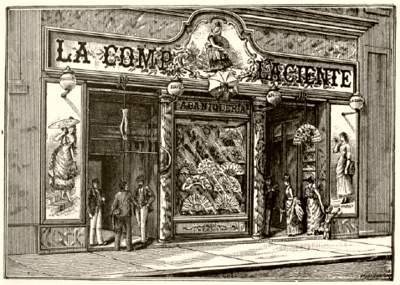 La calle de la Muralla es en lo inteetual ylo moral como una república independiente y altanera que no recibe los hálitos de sus vecinos, sino que antes al contrario impone sus teorías y su voluntad al resto de la población. Cuando acontece algo en la Península que influye en la conciencia nacional, las miradas se dirigen al que llamaremos baluarte, indagando el pensamiento que domina, ya para imitar sus manifestaciones ya para saber a qué atenerse. De allí parten las muestras de satisfacción o de indiferencia por los acontecimientos sociales o políticos de la madre patria, y cuando la maayoría de la población difiere, no se le contradice sino se le respeta. No siempre la calle de la Muralla ha sido simpática por sus demostraciones; imperan por tradición en ese centro comercial teorías que han dejado de ser populares y que allí se perpetúan por causas impenetrables. Es lástima que esto suceda, porque la calle es digna de toda clase de consideraciones, y ha puesto a gran altura el pabellón de su generosidad en circunstancias oportunas. Un poco de transigencia, un contacto más espiritual con el resto de la población, completarían su gloria.
La calle de la Muralla es en lo inteetual ylo moral como una república independiente y altanera que no recibe los hálitos de sus vecinos, sino que antes al contrario impone sus teorías y su voluntad al resto de la población. Cuando acontece algo en la Península que influye en la conciencia nacional, las miradas se dirigen al que llamaremos baluarte, indagando el pensamiento que domina, ya para imitar sus manifestaciones ya para saber a qué atenerse. De allí parten las muestras de satisfacción o de indiferencia por los acontecimientos sociales o políticos de la madre patria, y cuando la maayoría de la población difiere, no se le contradice sino se le respeta. No siempre la calle de la Muralla ha sido simpática por sus demostraciones; imperan por tradición en ese centro comercial teorías que han dejado de ser populares y que allí se perpetúan por causas impenetrables. Es lástima que esto suceda, porque la calle es digna de toda clase de consideraciones, y ha puesto a gran altura el pabellón de su generosidad en circunstancias oportunas. Un poco de transigencia, un contacto más espiritual con el resto de la población, completarían su gloria.
Casi todos los establecimientos que contiene la calle son buenos y algunos esplendorosos. No hay ramo de comercio que deje de estar representado muy dignamente, sobresaliendo entre las tiendas donde se espenden los efectos al menudeo, La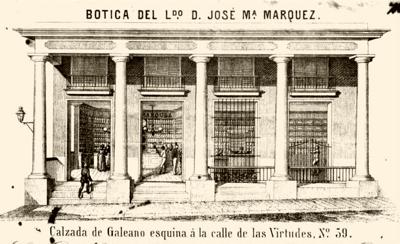 Colonial y Mestre y Martinica, grandes fábricas de chocolates; la florería El Ramillete; las locerías La Bomba y La Prueba; La Primavera, taller de modistas; las magníficas platerías de Misa y Lira de Oro; la antiquísima y siempre reputada tienda de paños El Navío; las tiendas de ropas La Perla y la Glorieta Cubana; la librería de Sans; las boticas de Santa Ana y San Julian; el célebre y reputado Palo Gordo, cada día más hermoso; la gran perfumería La Oriental; la galletería y biscochería Inglesa, única aquí en su clase y hasta el popular y excelente café La Victoria, que atrae a multitud de personas de otros barrios por saborear en especial café con leche. Los establecimientos que no hemos mencionado no dejan de ser menos dignos, habiendo magníficos almacenes ce géneros, quincalla, etc., ypara que nada falte a la calle de la Muralla, guarda a la redacción e imprenta del Diario de la Marina, que es el mas antiguo yfloreciente periódico de la Isla ydel que hablaremos en capítulo aparte, pues que también hemos de enterar al lector de la política que hacen este como otros diarios de la capital, para que sepa a qué atenerse cuando los lea, si acaso no les indigesta pronto su monotonía.
Colonial y Mestre y Martinica, grandes fábricas de chocolates; la florería El Ramillete; las locerías La Bomba y La Prueba; La Primavera, taller de modistas; las magníficas platerías de Misa y Lira de Oro; la antiquísima y siempre reputada tienda de paños El Navío; las tiendas de ropas La Perla y la Glorieta Cubana; la librería de Sans; las boticas de Santa Ana y San Julian; el célebre y reputado Palo Gordo, cada día más hermoso; la gran perfumería La Oriental; la galletería y biscochería Inglesa, única aquí en su clase y hasta el popular y excelente café La Victoria, que atrae a multitud de personas de otros barrios por saborear en especial café con leche. Los establecimientos que no hemos mencionado no dejan de ser menos dignos, habiendo magníficos almacenes ce géneros, quincalla, etc., ypara que nada falte a la calle de la Muralla, guarda a la redacción e imprenta del Diario de la Marina, que es el mas antiguo yfloreciente periódico de la Isla ydel que hablaremos en capítulo aparte, pues que también hemos de enterar al lector de la política que hacen este como otros diarios de la capital, para que sepa a qué atenerse cuando los lea, si acaso no les indigesta pronto su monotonía.
Lástima irremediable es la estrechez con que fue construida esta cono todas las demás calles de la sección de lo que fue intramuros de la ciudad, y que no le permita esta causa lucir todo su mérito. Cuando un efecto falte en el resto de los de la población, debe buscarse en la calle de la Muralla y allí es casi seguro encontrarle. Es cuanto podemos decir en obsequio de la respetable vía comercial, tan antigua como sólida, tan independiente como rica, tan generosa como severa. Lástima que no hayan podido ser nuestras alabanzas completas y que las ideas espansivas no hayan penetrado allí a la par que las riquezas. Culpa será de la humanidad que no es perfecta. A nosotros no nos incumbe reprobar nada sobre este punto; la conciencia debe de ser respetada y hemos terminado nuestro capítulo.
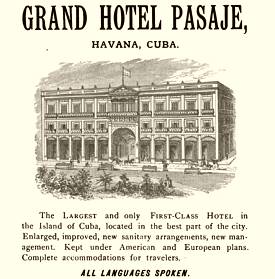
Para mis amigos en La Habana y para mi esposa (a la que llevo en el corazón) dejo mi ofrenda en el Templete que nos convoca cada año.
Enrique Domínguez, México
A los redactores de La Habana Elegante, gracias por este memorable paseo y bello homenaje. Mis deseos son de paz y que podamos reunirnos todos los cubanos. Mientras llega ese día, tenemos este árbol que no se seca.
Rosa Emilia Agramonte, Santiago de Chile
Cuando un amigo me recomendó esta revista no podía imaginar que me encontraría con esta sorpresa. La idea de recrear las tres vueltas a la ceiba y convertirla en una verdadera tradición es una de las inciativas que distigue a La Habana Elegante de otras revistas. Me conmueve esa memoria terca que nos recuerda cada año la ciudad. Prometo regresar cada año. Les deseo a todos los habaneros una noche feliz y esperanzada.
Alberto Rodríguez, Miami.
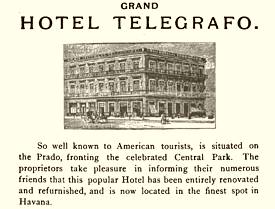
Las alamedas y el Parque
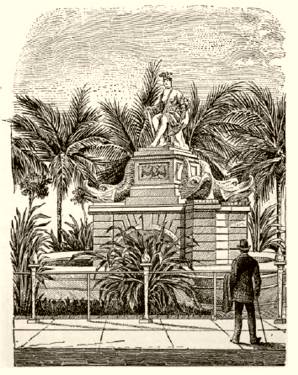 Al salir de las estrechas ypor este motivo calurosas calles, que causan mas sufrimientos que placeres al pedreste que las transita, se ve uno sorprendido al encontrarse en el centro de la ciudad con una espléndida y anchurosa vía bordada de árboles frondosos, que parece algo del Edén con que sueñan los europeos cuando piensan en estos países tropicales, de maravillosa vegetación, descritos con vivos colores, y que arrancaron al descubridor tan concisa como descriptiva frase al contemplar a Cuba: “Es la mas fermosa tierra que los ojos vieron.” Casi todo el ancho de la ciudad está atravesado por la alameda, que tomando nombres distintos segun sus divisiones, comienza en la calle del Príncipe Alfonso, antes calzada del Monte, y termina en el castillo de la Punta a la entrada del puerto. Parque de la India, Parque de Isabel la Católica, Parque Central y Paseo del Prado, son las denominaciones que toma la vía, sin rival no solo en la Habana sino en muchas ciudades de más encopetado tono. Comodidad, fresco y aseo de que se carece entre las calles se encuentran allí reunidos, y gracias a este respiro puede soportar la vida el hombre espansivo, que sin estos lugares le sería penosa.
Al salir de las estrechas ypor este motivo calurosas calles, que causan mas sufrimientos que placeres al pedreste que las transita, se ve uno sorprendido al encontrarse en el centro de la ciudad con una espléndida y anchurosa vía bordada de árboles frondosos, que parece algo del Edén con que sueñan los europeos cuando piensan en estos países tropicales, de maravillosa vegetación, descritos con vivos colores, y que arrancaron al descubridor tan concisa como descriptiva frase al contemplar a Cuba: “Es la mas fermosa tierra que los ojos vieron.” Casi todo el ancho de la ciudad está atravesado por la alameda, que tomando nombres distintos segun sus divisiones, comienza en la calle del Príncipe Alfonso, antes calzada del Monte, y termina en el castillo de la Punta a la entrada del puerto. Parque de la India, Parque de Isabel la Católica, Parque Central y Paseo del Prado, son las denominaciones que toma la vía, sin rival no solo en la Habana sino en muchas ciudades de más encopetado tono. Comodidad, fresco y aseo de que se carece entre las calles se encuentran allí reunidos, y gracias a este respiro puede soportar la vida el hombre espansivo, que sin estos lugares le sería penosa.
La fuente de mármol quo adorna el parque de la India y que por la obra toma el nombre, es una bella y magnífica escultura y de lo mejor que puede encontrarse en América. Se debe al espíritu patriótico y artístico del Intendente Pinillos, que fue hijo de esta ciudad y a más celoso de su esplendor, cosa que no ha tenido muchos imitadores después. La india Habana que preside la fuente, es un mito, pero recuerda con las formas de la más bella estética a la raza aborígen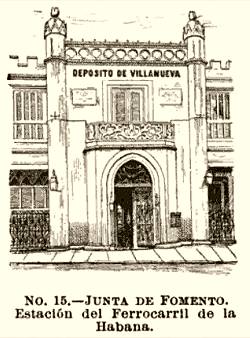 que cedió el puesto a la íbérica y a la africana, trasplantadas aquí. Es un monumento necesario y reparador, y digno del espíritu poético y caballeresco español. A la verdad que es de lo mas simpático que encierra la Habana y difícilmente encontrarían los hombres de estos tiempos creación que satisfaga mejor.
que cedió el puesto a la íbérica y a la africana, trasplantadas aquí. Es un monumento necesario y reparador, y digno del espíritu poético y caballeresco español. A la verdad que es de lo mas simpático que encierra la Habana y difícilmente encontrarían los hombres de estos tiempos creación que satisfaga mejor.
El parque de Isabel la Católica no tiene nada especial que describir, pues que el arte no ha reclamado desde hace mucho tiempo a nuestros administradores ningún gasto. El centro de este tramo del paseo está adornado con retazos de fuentes viejas, gracias a que los hombres de otras épocas se ocuparon de ernbelleeer su residencia, y algunos restos quedan de lo que adquirieron. Bancos de hierro aunque escasos, brindan descanso al paseante, que encuentra alegría no solo en el coposo verdor de los árboles, sino en el bullicioso pitar de millares de pájaros que se anidan en sus ramas. A uno de los lados se ostenta correcta línea de edificios nuevos, de buen aspecto aunque monótonos en su conjunto por la igualdad y por las gruesas columnas de los portales. El sistema anticuado de construcciones que en la Habana no se reforma da un aspecto melancólico a la ciudad, que contrasta con la alegría del cielo. ¿Para qué tantas piedras? No se ve la ventaja que ofrece ese modo de fabricar ni en la solidez ni en nada. El paradero y depósitos del ferrocarril de Villanueva ocupan el lado opuesto, causando mal efecto y dando pobre idea del espíritu emprendedor de esa Empresa.
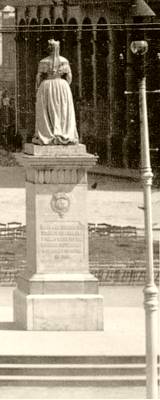 Viene despúes el Parque Central, más anchuroso que los demás y verdadero centro donde se esparce el ánimo yse refresca por las noches el cuerpo agobiado por el calor del día. Está bien trazado y mejor alumbrado, pero sin otra cosa digna de alabanza. Han puesto en el centro y precisamente en el sitio que reclama un kiosco y caja armónica para la música, a una estatua de poquísimo mérito artístico, por solo representar a una ex-reina y cuya obra no satisface a la vista siendo rémora de una necesidad. A la entrada de alguno de los otros parques haría buen efecto la estatua, y el kiosco daría mayor lucimiento al Central y a las bandas militares que obsequian con sus conciertos al público, en noches deliciosas que convidan a sentir y a gozar.
Viene despúes el Parque Central, más anchuroso que los demás y verdadero centro donde se esparce el ánimo yse refresca por las noches el cuerpo agobiado por el calor del día. Está bien trazado y mejor alumbrado, pero sin otra cosa digna de alabanza. Han puesto en el centro y precisamente en el sitio que reclama un kiosco y caja armónica para la música, a una estatua de poquísimo mérito artístico, por solo representar a una ex-reina y cuya obra no satisface a la vista siendo rémora de una necesidad. A la entrada de alguno de los otros parques haría buen efecto la estatua, y el kiosco daría mayor lucimiento al Central y a las bandas militares que obsequian con sus conciertos al público, en noches deliciosas que convidan a sentir y a gozar.
A las retretas mencionadas, que actualmente tienen lugar los lunes, miércoles y viernes, acude más público que los demás días, contándose bastaste señoras y señoritas que de otro modo no concurrirían al paseo, ni buscarían el fresco y el esparcimiento en beneficio de su salud, pues la mujer habanera está imbuida de rancias preocupaciones y cree que su concurso solo es natural cuando algún atractivo lo justifica. De esta como de otras ideas extravagantes son culpa la monotonía y falta de aliento que encuentra el hombre en todas partes, casi desiertos como los lugares públicos se ven por el sexo femenino, que es al que le toca embellecer la vida no solo con su presencia y sus galas sino con su contento. No es empero grande el número de personas de ambos sexos que concurren al Parque en las noches de retreta, exceptuando ciertas solemnidades, dada la población y siendo el único punto de esparcimiento de la ciudad, pues si bien parece lo contrario al que se sitúe en la parte que hace frente al teatro de Tacón, es, porque para mayor amaneramiento y falta de gracia, los paseantes no salen de ese corto tramo, apiñándose como si no hubiese más espacio. Todos andan graves y como pagados de su propia importancia; parece más que paseo una imposicion obligatoria que tienen las damas y los caballeros de codearse por el espacio de dos horas sin decirse oste ni agoste, y volverse a sus casas con tanto spleen como trajeron. Falta de las muchachas la naturalidad y el despejo que tanto realzan a las mujeres de las grandes ciudades y a los hombres el entusiasmo y la franqueza elegante de la juveatud europea.
Las damas que tienen carruage no se apean y pretextan escuchar la música, formándose por esta causa una molesta aglomeración de vehículos por la parte exterior de aquel indispensable tramo. Cuando se sabe que estas sibaritas no ejercitan sino muy raras ocasiones las piernas no puede uno menos que exclamar: ¡qué fastidio! Los amigos se acercan a saludarlas y a endulzar los oídos de la pretendida, y es el único conato de sociedad que se forma en el Parque aunque poco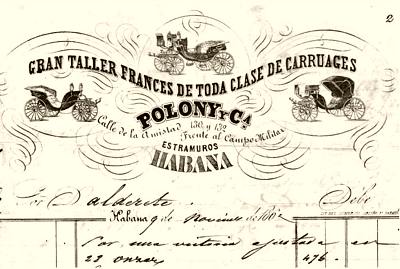 propio en la forma, pues que quedan los caballeros obligados a permaneeer entre un maremagnum peligroso.
propio en la forma, pues que quedan los caballeros obligados a permaneeer entre un maremagnum peligroso.
Algunos grupos de hombres se forman sin erubargo, y aunque en dos o tres de estos que son habituales se notan personas instruidas que cultivan con su conversación asuntos elevados, la mayoría son de jóvenes que no llevan otro objeto aparente sino reírse de sus propios dicharachos, siempre faltos de gracia y oportunidad y que molestan los oidos del hombre juicioso, dando pobrísima idea del estado mental de una generación que tiene elementos sobrados de perfeccionamientos. Con semejantes galanes, cómo han de brillar las mujeres!
Todo el rededor del Parque está poblado de vistosos edificios, alguno paralizada su construcción por causas imprevistas, yen el lado en que está el teatro de Tacón, de fama universal, están muy buenos cafés, restauranes y hoteles, resplandecientes de luz y de animación, mereciendo el café el Louvre por su fisonomía que le dediquemos uno de nuestros capítulos así como a la bulliciosa acera que toma su nombre y que se extiende hasta la calle de Neptuno.
Sigue después el paseo del Prado que nos lleva hasta el mar y que nada particular ofrece de mención a no ser su constante brisa y marítimo panorama. En este trayecto están el magnífico establecimiento hidrotepiraco de Belot, el Centro de Dependientes, sociedad de instrucción y recreo y el Círculo Militar, elegante casino de los hijos de Marte, con muchas comodidades yque como de reciente creación no se sabe aún de qué pié cojea.
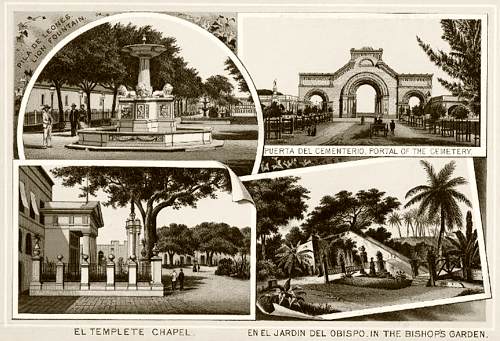
Quiero dejar un testimonio de mi cariño por la ciudad que perdure más que ella misma, para que siempre podamos volver aunque sea por los caminos del espacio cibernético. Yo adivino el parpadeo de las luces que a lo lejos, van marcando mi retorno… Y volver, volver, volver…
El hijo del Cerro, Caracas
Sigamos visitando este árbol espléndido que es solo una imagen fija, que no está en ninguna parte, para que sea de todos. Gracias a La Habana Elegante por mantener vivo el milagro de una ciudad que parece nacer de nuevo con cada entrega del Templete. Ojalá pronto podamos ser libres todos los cubanos y entrar y salir de la ciudad, no como extranjeros, ni como enemigos. Besos para todos.
Julia Jiménez, Orlando
Nocturno con fondo lunar
Juan Carlos Flores
Li Tai Po miraba la luna.
Por la época en que Li Tai Po miraba la luna
era un hombre muy descreído, muy solo.
Siendo expulsado del palacio por el emperador
andaba bucólico y nostálgico de montaña en montaña.
Li Tai Po miraba a la luna.
Cerraba los ojos y se iba quedando dormido.
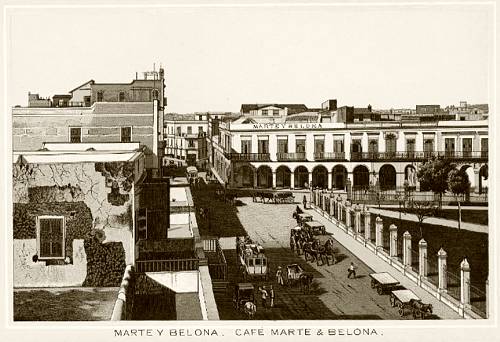
El Louvre
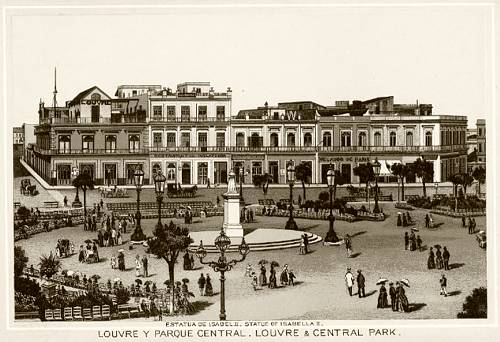 Es un hermoso café que está situado en la esquina donde comienza la calle de San Rafael y que sirve de punto de reunión a la gente de mundo que habita, ya como estable, ya como transitoria, esta ciudad. Salones espaciosos y ventilados, cubiertas sus paredes y columnas de espejos y brillantemente alumbrados, ofrece un lugar
elegante y céntrico a la multitud de empleados, militares, marinos, negociantes, etc., que carecen aquí de familia y que forman tertulias en las mesas del establecimiento, muy bien servido y provisto de cuanto puede antojársele al paladar más exigente. El bullicio que produce la incesante charla de los concurrentes, da un carácter de
fiesta atractiva, y puede decirse que si se cerrase el Louvre sería un día de duelo para los que saben saborear la vida, pues difícilmente se encontraría otro lugar en la ciudad que supliese al que vamos describiendo.
Es un hermoso café que está situado en la esquina donde comienza la calle de San Rafael y que sirve de punto de reunión a la gente de mundo que habita, ya como estable, ya como transitoria, esta ciudad. Salones espaciosos y ventilados, cubiertas sus paredes y columnas de espejos y brillantemente alumbrados, ofrece un lugar
elegante y céntrico a la multitud de empleados, militares, marinos, negociantes, etc., que carecen aquí de familia y que forman tertulias en las mesas del establecimiento, muy bien servido y provisto de cuanto puede antojársele al paladar más exigente. El bullicio que produce la incesante charla de los concurrentes, da un carácter de
fiesta atractiva, y puede decirse que si se cerrase el Louvre sería un día de duelo para los que saben saborear la vida, pues difícilmente se encontraría otro lugar en la ciudad que supliese al que vamos describiendo.
Multitud de personas de distintas categorías sociales acuden allí en pos de citas, ytambién tahures y toda clase de gente vividora o alegre que se conciertan para sus aventuras. Es el verdadero círculo de la gente despreocupada y traviesa de levita, que fragua planes de conquistas femeniles, de burlas a la policía, y de toda clase de negocios nonc santos. Los que son prácticos clasifican prontamente la calidad de los distintos grupos que por zonas toman posesión de las mesas del café a diferentes horas, y con una sola mirada pueden decir cómo anda el barómetro de la moralidad pública. En los altos hay juegos de billar y tresillo y algunas veces se dan bailes donde alternan las razas sin las preocupaciones que en otras esferas, bailando muchos jóvenes que se tienen por paletos y elegantes, con lavanderas y fregonas de color de ébano que huelen a sebo y a cebolla y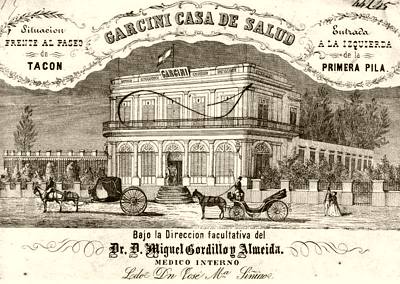 que fingen ocultar su rostro con la careta, que es de todas épocas en esta clase de bailes.
que fingen ocultar su rostro con la careta, que es de todas épocas en esta clase de bailes.
Pero dejemos el interior del Louvre que bajo su brillante aspecto tiene muchas telarañas y a las que echaremos un velo por no disgustar a las muchas personas intachables que allá concurren, y plantémonos en la acera que da frente al Parque y que es el lugar más animado y turbulento de la Habana y reflejo de nuestro carácter, que allí se ostenta con mayor espansión por estar al aire libre.
Es una semejanza aunque en menor escala de la Puerta del Sol de Madrid y un lugar verdaderamente alegre. Todo lo que no cabe dentro del café está, en la acera. Billeteros de todas las loterías nacionales, que gritan desaforadamente su mercancía; vendedores de periódicos y debastones, limpiabotas, limosneros, convidadores de garitos, truhanes de todas especies, jugadores, agentes o corredores de la tienda de Cupido; policía uniformada y secreta que todo lo husmea; vagos que esperan la llegada de algún amigo que los convide a cualquiera cosa, ycuantas clases de petardistas pueda imaginar el lector, se hallan allá en alegre roce con otras muchas gentes honradas que pasean por la anchurosa yelegante acera, gozosas de haber encontrado un lugar que contrasta por su belleza con la fealdad y estrechez del resto de la población. Allí se chismea todo lo que pasa ylo que no pasa; atraviesan las ninfas de ciertas calles para recordar su existencia ysus gracias a los disolutos, y también llegan en sus carruajes y a pie damas honestas yencopetadas a saborear los helados de París, que se confeccionan en un establecimiento especial.
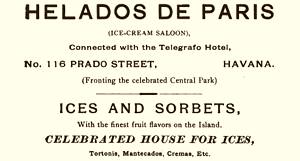 Se discuten las reputaciones, se cena en los buenos restaurantes, se bebe, se gesticula y se riñe. Es la acera del Louvre como la caja de Pandora, donde están los males y los bienes. Allí está todo o por allí pasa todo lo fashionable de la Habana. No hay necesidad de ir a otro sitio para hallar lo que se desea, y lo mismo se puede encontrar una mirada de virgen tropical que regenere hasta á un escéptico, que otra que conduzca a una sentina de corrupción; y puede encontrarse también un carterista que le escamotee la cartera del bolsillo.
Se discuten las reputaciones, se cena en los buenos restaurantes, se bebe, se gesticula y se riñe. Es la acera del Louvre como la caja de Pandora, donde están los males y los bienes. Allí está todo o por allí pasa todo lo fashionable de la Habana. No hay necesidad de ir a otro sitio para hallar lo que se desea, y lo mismo se puede encontrar una mirada de virgen tropical que regenere hasta á un escéptico, que otra que conduzca a una sentina de corrupción; y puede encontrarse también un carterista que le escamotee la cartera del bolsillo.
Los demás establecimientos de la acera son a cual mejores y se clasifican así:
Hotel yrestaurant de Inglaterra, el primero que se montó con lujo en esta ciudad y cuyo salón de comer se ve siempre muy concurrido.
Cosmopolitan, café y restaurant, donde se come muy bien y sobre todo, se cena.
Washington, café y también restaurant, muy decente.
Casino alemán, círculo privado, en los altos.
Helados de París.
Barbería el Louvre, acicalamiento de jóvenes a la moda.
Hotel y restaurant Hispano Americano, más modesto.
Como se ve y contando con los alrededores, puede vivirse muy confortablemente sin salir de este centro, que no tiene que envidiar mucho a los de otras capitales.
La Calle del Obispo
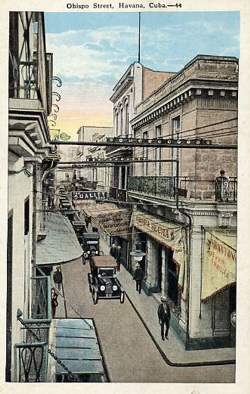 Comercial pasadizo entre la Plaza de armas y el Parque Central vamos a transitar, mirando a un lado y a otro los atractivos de la moda, las joyas relucientes, las porcelanas seductoras, las galas todas del trabajo y la inteligencia europea que se ostentan con profusión en la Habana. Un continuo cordón de carruajes en muchos de los cuales se muellen las damas más elegantes, se detienen aquí y allá, al frente de tiendas de todas clases, haciendo provisión sus dueñas de los efectos neeesarios para distinguirse en una sociedad cada día más exigente, que renueva a cada instante sus trajes, sus ajuares y hasta el modo de decir y saludar. Las leyes de la evolución y
Comercial pasadizo entre la Plaza de armas y el Parque Central vamos a transitar, mirando a un lado y a otro los atractivos de la moda, las joyas relucientes, las porcelanas seductoras, las galas todas del trabajo y la inteligencia europea que se ostentan con profusión en la Habana. Un continuo cordón de carruajes en muchos de los cuales se muellen las damas más elegantes, se detienen aquí y allá, al frente de tiendas de todas clases, haciendo provisión sus dueñas de los efectos neeesarios para distinguirse en una sociedad cada día más exigente, que renueva a cada instante sus trajes, sus ajuares y hasta el modo de decir y saludar. Las leyes de la evolución y 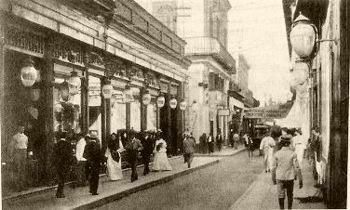 transformismo que ahora han acogido los filósofos con inusitada sorpresa, la descubrieron de nuevo mucho antes las mujeres con el auxilio de los catálogos de tiendas y periódicos de modas, que aparecen en las casas de familia allá por los rinconcitos donde no miran nunca los hombres, cuando tanta influencia ejercen estos impresos en el porvenir. Se devanan luego los secos ministros y legisladores poniendo cortapizas a las ideas que se desarrollan en periódicos y libros políticos, creyendo contener al espíritu humano, por el temor oculto aunque disfrazado, de que lleguen nuevas falanges a quitarles el puesto en el festín social y empobrecerlos, y no ven, miopes, que dentro de casa tienen la vorágine que los arrastra con mujer, hijos y criados, al campo revolucionario, donde por el poder de la industria y de la moda se confunden las clases sociales todas, vestidas de igual manera y en el que quedan vencedores los más audaces, mientras ellos cegados por el polvo, quedan sepultados en el abismo.
transformismo que ahora han acogido los filósofos con inusitada sorpresa, la descubrieron de nuevo mucho antes las mujeres con el auxilio de los catálogos de tiendas y periódicos de modas, que aparecen en las casas de familia allá por los rinconcitos donde no miran nunca los hombres, cuando tanta influencia ejercen estos impresos en el porvenir. Se devanan luego los secos ministros y legisladores poniendo cortapizas a las ideas que se desarrollan en periódicos y libros políticos, creyendo contener al espíritu humano, por el temor oculto aunque disfrazado, de que lleguen nuevas falanges a quitarles el puesto en el festín social y empobrecerlos, y no ven, miopes, que dentro de casa tienen la vorágine que los arrastra con mujer, hijos y criados, al campo revolucionario, donde por el poder de la industria y de la moda se confunden las clases sociales todas, vestidas de igual manera y en el que quedan vencedores los más audaces, mientras ellos cegados por el polvo, quedan sepultados en el abismo.
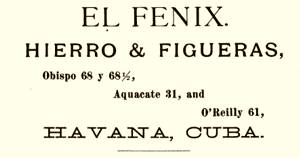 Y esta revolución tan demoledora ¿quién la hace? La hacen simplemente esos cuadernos sin autor o alguna escritora
Y esta revolución tan demoledora ¿quién la hace? La hacen simplemente esos cuadernos sin autor o alguna escritora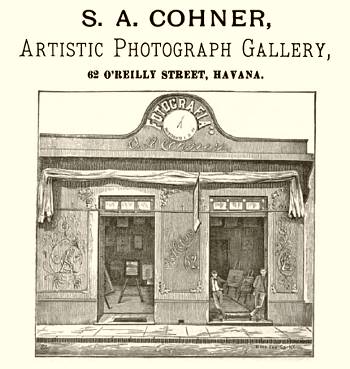 parlanchina que cuenta en periodiquines de modas o folletines, faustos de princesas y duquesas, yla rematan después algunos industriales modestos, exponiendo en las vidrieras de las tiendas todo el oropel aristocrático a precios ínfimos. ¿Qué mujer no es ahora la Pompadour o la Valois, o princesa rusa, por ocho o diez pesos en billetes? Así es que cuando la costurera va echando chispas con gasas de algodón ydiamantes californianos, la dama aristocrática se despecha y traga bilis primero yluego se traga la fortuna del marido comprando diariamente efectos caros para no quedar eclipsada; y así viene a despecho de los conservadores y cruzando mares de bayonetas y cañones el nivel social tan temido, por medio de la química y el estampado y por la presunción del bello sexo que no mide otra cosa sino varas de encajes y telas bordadas, mientras el grave y sesudo marido anda confundido, no sabiendo explicarse en presurosa ruina y echando la culpa al patronato, a Voltaire, a Proudhone y a los nihilistas, sin acordarse para nada de los papeles de modas de su mujer y de las tiendas de novedades.
parlanchina que cuenta en periodiquines de modas o folletines, faustos de princesas y duquesas, yla rematan después algunos industriales modestos, exponiendo en las vidrieras de las tiendas todo el oropel aristocrático a precios ínfimos. ¿Qué mujer no es ahora la Pompadour o la Valois, o princesa rusa, por ocho o diez pesos en billetes? Así es que cuando la costurera va echando chispas con gasas de algodón ydiamantes californianos, la dama aristocrática se despecha y traga bilis primero yluego se traga la fortuna del marido comprando diariamente efectos caros para no quedar eclipsada; y así viene a despecho de los conservadores y cruzando mares de bayonetas y cañones el nivel social tan temido, por medio de la química y el estampado y por la presunción del bello sexo que no mide otra cosa sino varas de encajes y telas bordadas, mientras el grave y sesudo marido anda confundido, no sabiendo explicarse en presurosa ruina y echando la culpa al patronato, a Voltaire, a Proudhone y a los nihilistas, sin acordarse para nada de los papeles de modas de su mujer y de las tiendas de novedades.
Y no se alarmen los tenderos por estas revelaciones nuestras, pues por más que se patenticen no han de variar las cosas tal como las han puesto los tiempos, y el comercio ha de seguir cada día mas próspero, cumpliendo la humanidad con su destino.
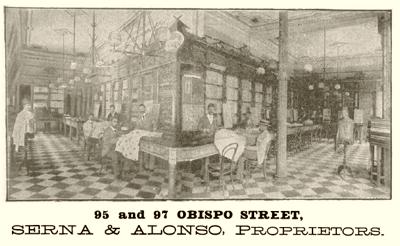 La calle del Obispo representa el espíritu innovador de la época y no frece nada tradicional que considerar. Cuando han llegado épocas de crisis se la ha visto abatida, cerrando puertas ydisminuyendo artificios, y así que ha renacido la calma, aparecer de nuevo más diamante y convidadora al lujo, con firmas y rótulos nuevos. No hace aún mucho tiempo infundía terror en las almas timoratas el espectáculo que presentaba la calle, y éstas al pasar y
La calle del Obispo representa el espíritu innovador de la época y no frece nada tradicional que considerar. Cuando han llegado épocas de crisis se la ha visto abatida, cerrando puertas ydisminuyendo artificios, y así que ha renacido la calma, aparecer de nuevo más diamante y convidadora al lujo, con firmas y rótulos nuevos. No hace aún mucho tiempo infundía terror en las almas timoratas el espectáculo que presentaba la calle, y éstas al pasar y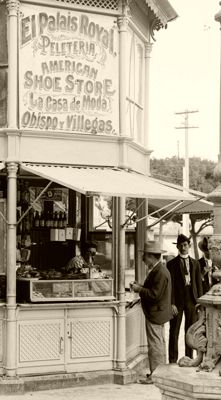 ver que cada día se despoblaba más, salían exclamando: “No hay esperanzas, la isla de Cuba está hundida!” Descorazonaba efectivamente mirar desaparecer el simpático comercio de la más céntrica vía, y parecían sus heridas las de todo el mundo. Hoy ha renacido como el ave Fénix con mayor esplendor y atractivo y también ha dado confianza a los tristes pesimistas que a cada rato se figuran con la maleta en la mano, en busca del alimento que creen les ha de faltar en la tierra de los plátanos y los ñames.
ver que cada día se despoblaba más, salían exclamando: “No hay esperanzas, la isla de Cuba está hundida!” Descorazonaba efectivamente mirar desaparecer el simpático comercio de la más céntrica vía, y parecían sus heridas las de todo el mundo. Hoy ha renacido como el ave Fénix con mayor esplendor y atractivo y también ha dado confianza a los tristes pesimistas que a cada rato se figuran con la maleta en la mano, en busca del alimento que creen les ha de faltar en la tierra de los plátanos y los ñames.
Y muy risueña y muy bonita está la calle del Obispo. Así que se comienza a andar se tropieza con un rico almacén de pianos, instrumento que en manos de la mujer anima tanto las ciudades cultas, porque siempre saben sacar de ellos en dulces armonías una 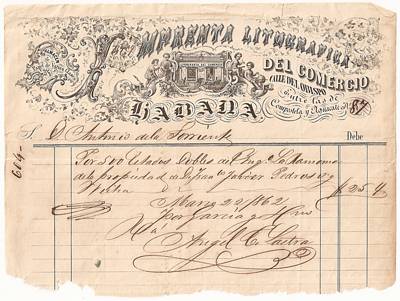 parte de sus almas sensibles; pertenece el establecimiento a los señores Esperez y hermano. Vienen después por sucesión infinidad de establecimientos vistosos que iremos nombrando sin detenernos mucho en ellos porque no parezcan interesadas estas citas. El Valle del Yumurí, lindísima tienda de fantasías parisiens, instalado con gusto exquisito; depósito elegante de máquinas de coser de Singer donde además hay mil efectos útiles de la industria americana; La Fashionable, linda tienda de modistas donde se ven a menudo fastuosos trajes de recepción y de baile; la magnífica joyería y relojeria El Bon Marché, del apreciable Sr. Enrique Schoechlin, que ha agradecido a la ciudad su fortuna dotándola con tan elegante tienda, que se distingue por los costosos kioscos traídos de Europa. Merece un aplauso este caballero suizo y no se lo escatimamos. Platería La Marina; La Joven América, locería; café y dulcería La Abeja Montañesa; Ciudad de Londres, sastrería; las tiendas de sedería y ropas que llevan el nombre de Correo de París; la sombrerería del popular Celestino Alvarez; Kramer, relojería; La Reina de las Flores, soberbia peluquería francesa digna de la capital de la elegancia y que justifica su poético rótulo; el Bosque de Bolonia, también fascinador por sus artículos y buen gusto parisiense; La Dalia Azul,
parte de sus almas sensibles; pertenece el establecimiento a los señores Esperez y hermano. Vienen después por sucesión infinidad de establecimientos vistosos que iremos nombrando sin detenernos mucho en ellos porque no parezcan interesadas estas citas. El Valle del Yumurí, lindísima tienda de fantasías parisiens, instalado con gusto exquisito; depósito elegante de máquinas de coser de Singer donde además hay mil efectos útiles de la industria americana; La Fashionable, linda tienda de modistas donde se ven a menudo fastuosos trajes de recepción y de baile; la magnífica joyería y relojeria El Bon Marché, del apreciable Sr. Enrique Schoechlin, que ha agradecido a la ciudad su fortuna dotándola con tan elegante tienda, que se distingue por los costosos kioscos traídos de Europa. Merece un aplauso este caballero suizo y no se lo escatimamos. Platería La Marina; La Joven América, locería; café y dulcería La Abeja Montañesa; Ciudad de Londres, sastrería; las tiendas de sedería y ropas que llevan el nombre de Correo de París; la sombrerería del popular Celestino Alvarez; Kramer, relojería; La Reina de las Flores, soberbia peluquería francesa digna de la capital de la elegancia y que justifica su poético rótulo; el Bosque de Bolonia, también fascinador por sus artículos y buen gusto parisiense; La Dalia Azul,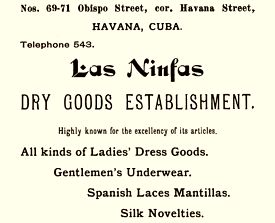 tienda de ropas; La Francia, verdadero centro de la revolución, donde se ofrecen las
tienda de ropas; La Francia, verdadero centro de la revolución, donde se ofrecen las 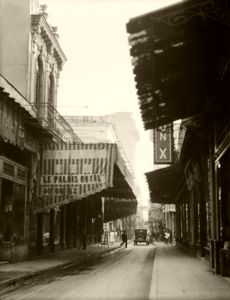 telas más vistosas al alcance de todo el mundo; Botica de La Luz; sastrería de Aranguren; Inglaterra, otra tienda de ropas de empuje; El modelo, id; La Discusión, sastrería; La Germanía, sombrerería; plantas y semillas de A. D. Predegal; El Jardín, florería; Imprenta Central, de dos apreciables jóvenes; librería de Villa, que sube como la espuma yprotege las letras cubanas; La Gran Señora, peletería; Cuesta y comp., platería; Gronzález y Gonzálex, ópticos; S. B. Haase, antiguo y reputado bazar de objetos de arte, prendería y óptica; biscochería de París; La Bota de París, zapatería; Las Filipinas, conocida tienda de ropas; Perfumería Habanera; La Sociedad, sastrería económica; librería de Elías Fernández; La Galería Literaria, libros y periódicos ilustrados de Madrid; El Mallorquin, café y chocolate; Europa, grande y concurrido café y dulcería, etc.; La Imperial, peletería; El Paseo, id.; J. Navalon, sastrería elegante; Botica de Basset; El Modelo Cubano, chocolatería y armas; La Diana, gran tienda de ropas; El anteojo, quíncallería; La Granada, tienda de ropas; galletería y comestibles de Santo Domingo, muy renombrada; La Hispano Cubana, sombrerería; La Mariposa, locería; La Dominica, peletería; La Australia, perfumería; Botica de Santo Domingo.
telas más vistosas al alcance de todo el mundo; Botica de La Luz; sastrería de Aranguren; Inglaterra, otra tienda de ropas de empuje; El modelo, id; La Discusión, sastrería; La Germanía, sombrerería; plantas y semillas de A. D. Predegal; El Jardín, florería; Imprenta Central, de dos apreciables jóvenes; librería de Villa, que sube como la espuma yprotege las letras cubanas; La Gran Señora, peletería; Cuesta y comp., platería; Gronzález y Gonzálex, ópticos; S. B. Haase, antiguo y reputado bazar de objetos de arte, prendería y óptica; biscochería de París; La Bota de París, zapatería; Las Filipinas, conocida tienda de ropas; Perfumería Habanera; La Sociedad, sastrería económica; librería de Elías Fernández; La Galería Literaria, libros y periódicos ilustrados de Madrid; El Mallorquin, café y chocolate; Europa, grande y concurrido café y dulcería, etc.; La Imperial, peletería; El Paseo, id.; J. Navalon, sastrería elegante; Botica de Basset; El Modelo Cubano, chocolatería y armas; La Diana, gran tienda de ropas; El anteojo, quíncallería; La Granada, tienda de ropas; galletería y comestibles de Santo Domingo, muy renombrada; La Hispano Cubana, sombrerería; La Mariposa, locería; La Dominica, peletería; La Australia, perfumería; Botica de Santo Domingo.
Aquí llegamos a la esquina de la calle de Mercaderes, y aunque sigue la del Obispo hasta el muelle, cambia la decoración por entrar en el centro del Gobierno y de los agiotistas de bolsa y tener nuestra pluma que hacer nuevos enristres. Los establecimientos de la línea que hemos recorrido suman ciento cuarenta yocho. Todas las industrias ybellas artes están honoríficamente representadas y el público mira con particular cariño a la calle del Obispo que es un buen representante de la civilización del siglo XIX.
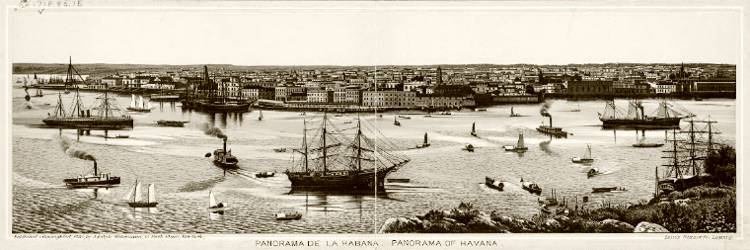
Hace cuarenta años que no veo La Habana. He vivido en París, en Madrid y en San Juan. Pero La Habana se ha convertido en una ciudad lejana, a la que solo puedo entrar por mis recuerdos. Es una ciudad extraña y la extraño. Por eso entrar a este Templete es para mí tan importante. Gracias por hacer posible mi regreso cada año.
El huésped del Hotel Pasaje
La Calle de San Rafael
 Otro semi-boolevar se nos presenta por el que conducir anuestros lectores, pues basta ahora hemos huido de meternos en calles faltas de atractivos, temerosos de fastidiar con la charla de los defectos de nuestras costumbres. Quizá mas adelante diremos alguna cosa. Ya
hemos hablado del famoso Louvre; frente tenemos un costado del gran teatro de Tacón, imponente edificio por sus dimensiones. Un catalan hijo del pueblo, y de escasa instrucción llevó a cabo esta obra en una época en que la Habana era respecto al presente, casi una aldea, y es la diferencia que siempre encontramos entre los hombres y
gobiernos pasados y los presentes, cuando nos ponemos a examinar las cosas. Tomaremos de una reciente publicación algunos datos sobre lo que representa ese teatro:
Otro semi-boolevar se nos presenta por el que conducir anuestros lectores, pues basta ahora hemos huido de meternos en calles faltas de atractivos, temerosos de fastidiar con la charla de los defectos de nuestras costumbres. Quizá mas adelante diremos alguna cosa. Ya
hemos hablado del famoso Louvre; frente tenemos un costado del gran teatro de Tacón, imponente edificio por sus dimensiones. Un catalan hijo del pueblo, y de escasa instrucción llevó a cabo esta obra en una época en que la Habana era respecto al presente, casi una aldea, y es la diferencia que siempre encontramos entre los hombres y
gobiernos pasados y los presentes, cuando nos ponemos a examinar las cosas. Tomaremos de una reciente publicación algunos datos sobre lo que representa ese teatro:
“El teatro de Tacón acupa una superficie de 6176 varas cuadradas; tiene por el frente tres puertas, seis por la calle de San Rafael, tres por la del Consulado y dos que dan a la de San José. En la esquina que forman las calles del Prado y San Rafael, está el café llamado Salon Brunet.
“Fijándonos en la parte interior del teatro, veremos que la platea y el escenario miden una extensión de 42.83 metros de largo, por [¿2?]0.68 de ancho, y la embocadura 17. 36. Las localidades pueden repartirse del modo siguiente: 56 palcos de 1.º y 2.º piso, 8 id del 3.º, 6 grillés, 112 butacas de tercer piso, 552 lunetas, 101 sillones delanteros de tertulia, 500 asientos de tertulia, 103 sillones delanteros de paraíso, 500 asientos de idem. Este número de asientos da cabida a 2,287 espectadores, que sumados con 750 más que pueden colocarse de pie detrás de los palcos, hacen 8000 personas que pueden asistir a una función. El alumbrado consta de 1,034 quemadores de gas; el decorado se compone de 751 telones, bastidores, bambalinas, etc.; la sala de armas posee 605 piezas de diferentes clases; el guardarropa 13,787 trajes; los muebles y útiles de la escena llegan a 782; el archivo contiene mas de 1,200 libretos de obras líricas ydramáticas....”
Mas no te entusiasmes demasiado, lector, con las grandezas anotadas, porque ya casi todo el decorado está en ruinas y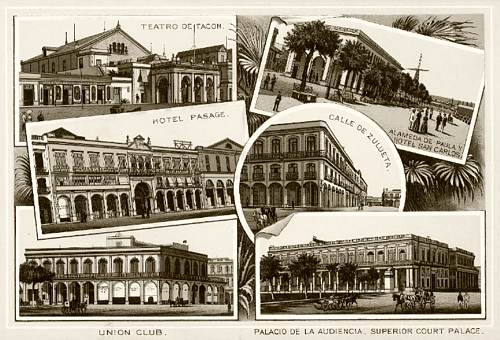 los trajes hechos visiones. No ha tenido reemplazo el que creó esas maravillas.
los trajes hechos visiones. No ha tenido reemplazo el que creó esas maravillas.
Después, hasta llegar a la calzada de Galeano, siguen una doble fila de establecimientos, que hasta la mitad de la calle indican el dominio del sexo bigotudo. Restauranes, barberías, sombrererías, sastrerías y zapaterías incitan a elegantizarse al más despreocupado, y la animación que producen los indispensables carruages, hacen de la calle de San Rafael un lugar favorito. Es también sitio preferente de las quincallerías, que se aumentan, llamando la atención con sus múltiples y vistosos objetos. Iremos indicando los establecimientos, según los vamos encontrando, sorprendidos siempre por el número de los que cuenta la Habana.
El Refrigerador Central, que recuerda los Lunch Rooms de Nueva York. Ha popularizado el uso del lager bieer de los alemanes, con tan buen éxito, que cuesta trabajo por las noches conseguir puesto para empinar el codo. La Granja, favorito café de los que prefieren un buen artículo a lucir el taco; Las Tullerías, antiguo restaurant de placentera historia; el Louvre, restaurant, tan bueno para comer como para probar que se come. En los altos se le rinde culto constante a Tersípcore por gente de todos colores y triviales y disolutas costumbres. Sombrerería El Louvre; Eliseo Badía, sastre; Locería y Cristalería; Cervantes, café y billar; Los Tiroleses, quincallería famosa; Fernandez Canto y comp., almacén de víveres digno de ser recomendado; Valles, sastre popular que imita a Nicolls el de 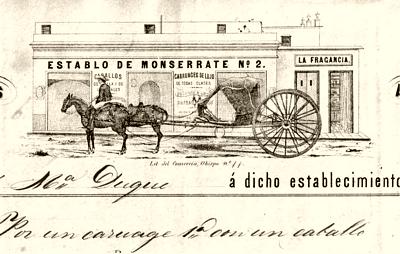 Nueva York en lo de anunciarse y complacer; confitería,que por llamarse de Lourdes, indica milagros; barbería y peluquería El Oriente; el famoso Néctar Soda, favorito de las damas; Los Puritanos, qaincallería; sombrerería de Morell; id. de Cándido Junquera; Naranjo, zapatería; A. T. Rodríguez, sastre; Mazas y comp., sombrerería; Los Bohemios, sastrería; Agustín Alvarez, fábrica de sombreros; Ropa Hecha. Estamos en la esquina de la calle de la Amistad donde nos detendremos delante de la casa escuela gratuita de la institución Zapata, para rendir homenage a un benemérito ciudadano que legó un capital para la instrucción pública. Pocas veces encontraremos entre nosotros tan bello ejemplo.
Nueva York en lo de anunciarse y complacer; confitería,que por llamarse de Lourdes, indica milagros; barbería y peluquería El Oriente; el famoso Néctar Soda, favorito de las damas; Los Puritanos, qaincallería; sombrerería de Morell; id. de Cándido Junquera; Naranjo, zapatería; A. T. Rodríguez, sastre; Mazas y comp., sombrerería; Los Bohemios, sastrería; Agustín Alvarez, fábrica de sombreros; Ropa Hecha. Estamos en la esquina de la calle de la Amistad donde nos detendremos delante de la casa escuela gratuita de la institución Zapata, para rendir homenage a un benemérito ciudadano que legó un capital para la instrucción pública. Pocas veces encontraremos entre nosotros tan bello ejemplo.
En el tramo siguiente varía la fisonomía de la calle, por las grandes tiendas de géneros que dan el dominio al sexo bello. Templo de Diana, quincallerfa; botica Cosmopolitana del Dr. Pormel; sedería La Diana; Arcaño, sastre; Las Tullerías, camisería; La Central, vidriería y grabados: Domingo Palli, zapatero; Taller de instalaciones de gas y agua; ferretería La Florida; ferreterfa de San Rafael; La Quinta Avenida, gran quincallería y emporio de novedades; Club Almendares, vistosa tienda de ropas; café El Nuevo Mundo; El Bazar, peletería; El Louvre, tren de coches de alquiler; La Traviata, tienda de ropas: sedería del Bazar Parisien; La Especialidad, camisería; lindo depósito de la fábrica habanera de perfomería de Crueellas, cayos productos son muy recomendables y merecen protección; El Bazar Parisien, famosa tienda de ropas; Los Estados Unidos, otra tienda de ropas como La Francia de la calle del Obispo; La Moda, peletería.
Aquí terminamos, porque la calle en vez de mejorar su anchura, sigue estrecha y triste. Doblaremos por Galeano, que es la vía mas típica de la Habana y una de las pocas que ofrece comodidades al pedreste.
La Calzada de Galiano
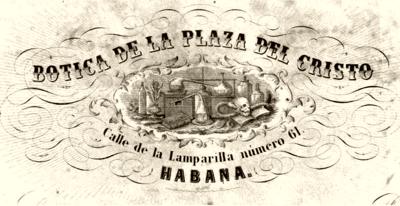 Pasemos a otras sensaciones. Vamos saliendo de los barrios que nos recuerdan a Tiro por lo comercial, y entramos en una calle que bajo otro aspecto nos recuerda tambien a esas ciudades prehistóricas de las que quedan solo restos. Persépolis, Nínive, Babilonia, etc., vienen involuntariamente a la memoria al contemplar las largas filas de macizas columnas, sin gracia arquitectónica y que dio carácter tan monumental y pesado a construcciones de una época en que todo es lijero y artístico y en que la industria del hierro facilita al arquitecto los medios de lucírsela con poco costo, brindándole en delgado paral la resistencia de una pirámide. Mas a pesar de este defecto, sorprende agradablemente la calzada de Galiano al salirse de las estrechísimas y malsanas calles que componen casi toda esta poblacion, por la novedad que ofrece y porque nos hallamos en un centro social que nos empieza a apartar de los negocios y materialismos de la vida.
Pasemos a otras sensaciones. Vamos saliendo de los barrios que nos recuerdan a Tiro por lo comercial, y entramos en una calle que bajo otro aspecto nos recuerda tambien a esas ciudades prehistóricas de las que quedan solo restos. Persépolis, Nínive, Babilonia, etc., vienen involuntariamente a la memoria al contemplar las largas filas de macizas columnas, sin gracia arquitectónica y que dio carácter tan monumental y pesado a construcciones de una época en que todo es lijero y artístico y en que la industria del hierro facilita al arquitecto los medios de lucírsela con poco costo, brindándole en delgado paral la resistencia de una pirámide. Mas a pesar de este defecto, sorprende agradablemente la calzada de Galiano al salirse de las estrechísimas y malsanas calles que componen casi toda esta poblacion, por la novedad que ofrece y porque nos hallamos en un centro social que nos empieza a apartar de los negocios y materialismos de la vida.
Conócese ahora íntimamente a la Habana, y las familias vienen a recojer nuestra atención, ocupada con el populoso y 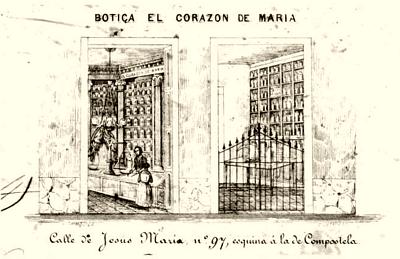 cosmopolita comercio que impera por todas partes. Vemos, sin embargo de que también le van robando sitio las tiendas a los particulares, que muchas de las casas están habitadas por familias, escuchándose tras los portales un bullicio simpático, y viéndose asomar las atractivas caras de la juventud y el entrar y salir en alegre retozo de los niños, produciendo este conjunto un cambio de ideas y de deseos.
cosmopolita comercio que impera por todas partes. Vemos, sin embargo de que también le van robando sitio las tiendas a los particulares, que muchas de las casas están habitadas por familias, escuchándose tras los portales un bullicio simpático, y viéndose asomar las atractivas caras de la juventud y el entrar y salir en alegre retozo de los niños, produciendo este conjunto un cambio de ideas y de deseos.
La sociedad cubana tiene todas sus glorias dentro de sus moradas; allí es espansiva, espléndida y generosa. Las mujeres, que tan mal se encuentran, como cohibidas en las vías públicas, están a sus anchas dentro de sus nidos y se muestran simpáticas y encantadoras. A veces parecen muy lánguidas, mas reservan para sus ojos toda la energía, y éstos dejan entrever un paraíso de dulzuras. ¿Dónde la mujer no reasume toda la vida y dónde no alienta é ilumina al hombre?
Sirve esta calle como de comienzo a dos barrios populosos: el de Monserrate y el de la Salud. El primero es el más favorito del sexo bello, y los Tenorios tienen allí largo campo donde ensayar sus aptitudes para atrapar simpatías y decisiones. No les intimide la displiecencia aparente de las muchachas, pues como se dice que ahora escasean los pretendientes, deben tener ellas una provisión de sies en la punta de la lengua, que con poco esfuerzo harán salir. El no es monosílabo poco simpático a las protectoras de la cascarilla.
Tiene la Habana, en medio de sus interminables defectos, algo original que seduce y hace que se perdonen aquellos. Tal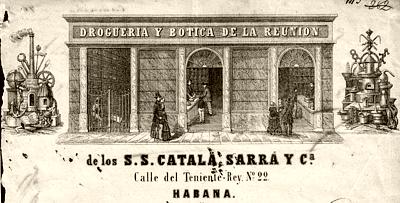 atractivo empieza a experimentaree en la calle en que estamos; el gusano roedor del amor se introduce en nuestro pecho, y vamos como el cordero a la muerte, resignados, en busca de unos ojos, de una mirada que nos esclavicen. El amor es el imán de la humanidad; cuando estamos bajo su influencia todo cuanto nos rodea nos parece perfecto. Las columnas ridículas para el crítico, que dan aire de ruinas a la calzada de Galiano, toman formas vaporosas cuando en nuestra mente las miramos bajo el prisma de las simpatías, y sirven de peristilo a un templo de diosas, que pueblan extensos barrios, y son sencillas y amorosas y ardientes como el sol.
atractivo empieza a experimentaree en la calle en que estamos; el gusano roedor del amor se introduce en nuestro pecho, y vamos como el cordero a la muerte, resignados, en busca de unos ojos, de una mirada que nos esclavicen. El amor es el imán de la humanidad; cuando estamos bajo su influencia todo cuanto nos rodea nos parece perfecto. Las columnas ridículas para el crítico, que dan aire de ruinas a la calzada de Galiano, toman formas vaporosas cuando en nuestra mente las miramos bajo el prisma de las simpatías, y sirven de peristilo a un templo de diosas, que pueblan extensos barrios, y son sencillas y amorosas y ardientes como el sol.
Comienza la calzada en la de San Lázaro y termina en la de la Reina. Al llegar a la calle de la Concordia se encuentra la iglesia parroquial de Monserrate, única para un barrio de cuarenta mil habitantes y en la que apenas caben seiscientas personas. Esta insuficiencia marca la mudanza de los tiempos y de las ideas entre las dos épocas en que se fomentaron la parte antigua llamada in-tramuros y la moderna, ex-tramuros. La primera, edificada antes de la revolución filosófica, está poblada, al estilo de las ciudades peninsulares, de muchos templos costosos; en la parte de estos tiempos, una iglesita de aldea, sin ornato, sirve para cristianizar a una población como la que tendría la Habana antigua, y el clero no se inquieta por el pobre 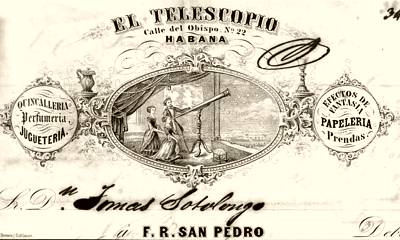 servicio que presta a cambio de pingües beneficios. ¿Habrá invadido la filosofía también al clero?
servicio que presta a cambio de pingües beneficios. ¿Habrá invadido la filosofía también al clero?
Va a notar el lecter que entre el comercio que se va apoderando de la calzada y que vamas a reseñar, dominan las mueblerías: se han colocado como de atalaya para vigilar la creación de las familias y para hacerse también más visibles y animar a los solteros recalcitrantes. En todas estas indispensables tiendas hay muebles de segunda mano al alcance de la más inmodesta fortuna.
Farmacia La Fé; ferretería Los Dos Leones; café y dulcería La Perla, frente a la iglesia y lugar muy favorecido por los jóvenes del barrio; mueblería del mismo nombre; ferretería El Compás; taller de composión de pianos y de toda clase de instrumentos de música; mueblería de Cayon; Santiago Apóstol, colegio de educación que ocupa una casa rodeada de árboles; Gran fábrica de sombreros; peletería El Paraíso; botica Ntra. Sra. de Monserrate; La Guirnalda, sedería; La Pastora, locería; El Comercio, tienda de ropas; café y billar La Angelita; sedería La Casualidad; La Asturiana, mueblería; El Triunfo, sastrería y camisería; El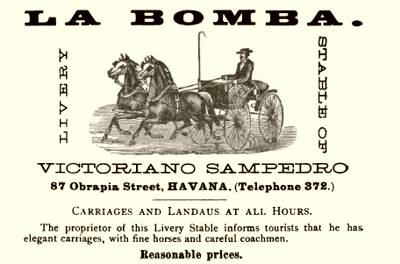 Boulevard, sastrería; café y billar La Isla; peletería La Moda; ídem Palacio de Cristal; mueblería La Barcelonesa; ídem El Bazar; la magnífica panadería de Viena; café El Mundo; botica de F. M. Alvarez; taller de marmolería; La Favorita, mueblería; Laburu y comp., ídem; New-York House, gran casa de huespedes; La América, locería; La Llave, ferretería; depósito de máquinas de coser de La Nueva Remington; La Campana, ferretería; Villa de Colage, tienda de ropas; café El Convenio; La Vajilla, locería; La Unión, mueblería; ídem de J. Vidal; ídem La América. Siguen filas de tiendas de diferentes mercancías y de menos importancia, hasta llegar a la Plaza del Vapor, mercado que merecerá capítulo aparte. Nos quedan aún por poner. El Oriente, camisería y ropa hecha; ferretería de Dragones; La Brisa, peletería; fonda antiquísima Los Dos Leones, y las bien montadas tiendas de efectos asiáticos de los celestiales cayos nombres ponen en gruesos caracteres chinos y hacen traducir en sonidos castellanos con estas letras: Quon-Sang-Wing. El que visite estas casas puede hacerse la ilusión de un viaje al celeste imperio.
Boulevard, sastrería; café y billar La Isla; peletería La Moda; ídem Palacio de Cristal; mueblería La Barcelonesa; ídem El Bazar; la magnífica panadería de Viena; café El Mundo; botica de F. M. Alvarez; taller de marmolería; La Favorita, mueblería; Laburu y comp., ídem; New-York House, gran casa de huespedes; La América, locería; La Llave, ferretería; depósito de máquinas de coser de La Nueva Remington; La Campana, ferretería; Villa de Colage, tienda de ropas; café El Convenio; La Vajilla, locería; La Unión, mueblería; ídem de J. Vidal; ídem La América. Siguen filas de tiendas de diferentes mercancías y de menos importancia, hasta llegar a la Plaza del Vapor, mercado que merecerá capítulo aparte. Nos quedan aún por poner. El Oriente, camisería y ropa hecha; ferretería de Dragones; La Brisa, peletería; fonda antiquísima Los Dos Leones, y las bien montadas tiendas de efectos asiáticos de los celestiales cayos nombres ponen en gruesos caracteres chinos y hacen traducir en sonidos castellanos con estas letras: Quon-Sang-Wing. El que visite estas casas puede hacerse la ilusión de un viaje al celeste imperio.
Juan Franqueza. Directorio Criticón de la Habana. Parte primera. Habana: Imp. de Montiel, 1883.
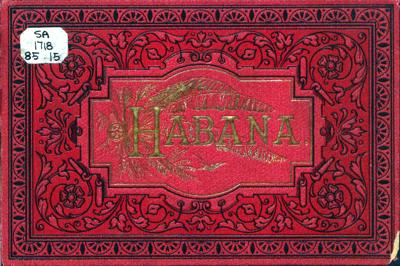
Deseo que pronto todos los cubanos, y en especial los habaneros, podamos reunirnos junto al Templete de la ciudad; que dar esas tres vueltas demore días y semanas, tanto tiempo como el que nos llevará abrazarnos a todos. Mientras llega ese día tenemos este lugar, bellísimo (¿dónde encuentran tantos tesoros viejos, tanta memoria de la ciudad?) para juntarnos y desear que la ceiba, con sus raíces, siga protegiendo la ciudad, incluso de la ciudad misma.
Estela Ordaz, Miami
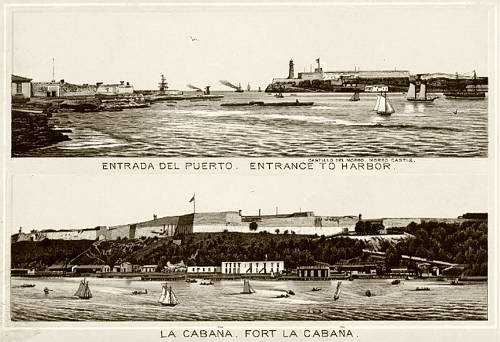
The Emergence of the Ceiba Tree as Symbol in the Cuban Cultural Landscape*
Paul Barrett, Assistant Professor of Art History
University of North Texas
Abstract: The ceiba tree on Havana’s Plaza de Armas has undergone various physical changes through time, from replanting to reconfiguration with the addition of civic monuments. Indeed, the tree’s social functions and meanings for the city’s population have undergone various periods of creation and revision. By the eighteenth century, the ceiba of Havana was known as the site where the Spanish conquistadors held the first Christian mass and town council meeting of the city in the sixteenth century, an invented tradition tied to a late colonial academicism and a search for origins and identity. Yet few studies have attempted to get beneath the myth to undercover a broader set of possibilities as to how this tree in Havana became an important multivalent symbol in the Cuban cultural landscape. How was its Early Modern and Modern significance, for example, informed by indigenous Americans, colonialism, slavery, revolutionary events, and African American culture, from pre-Contact times to the present? Every November 16th, the city honors the tree with rituals that reveal the influence of both civic traditions and Afro-Cuban religious practices. The diverse historical actors and audiences associated with the ceiba of Havana played an under-investigated role in its contemporary significance.
 Visitors to Havana, Cuba’s colonial zone will notice a change in the local routines during the November 16th celebration of the city. A holiday to honor the city’s patron Saint Christopher, the festivities culminate with a trip to the Plaza de Armas, where a crowd awaits to circumambulate the legendary ceiba tree of Havana three times in a counterclockwise motion (Figure1). Housed within the stone confines of a nineteenth-century memorial, known as El Templete, the tree was inscribed by this monument and the work of eighteenth-century historians, as the foundational site where the Spanish conquistadors held the first Christian mass and cabildo (town council meeting) beneath its formidable canopy in the sixteenth century.(1) Documentary evidence for this sixteenth-century event, however, is scarce, perhaps non-existent. Rather the appearance of the legend in late eighteenth-century texts and visual imagery, suggest the town-founding event under the ceiba tree as a late colonial invented tradition. Yet, where did this “tradition” come from? Or does the significance of the ceiba tree of Havana belong more to its function as a continuously redefined symbolic object? Does its significance derive from its place as a physical aspect of the urban landscape, a focal point for ritual practice, and more broadly an element of the Cuban cultural landscape of colonialism, slavery, revolutionary events, and African American culture in the history of the Atlantic World?
Visitors to Havana, Cuba’s colonial zone will notice a change in the local routines during the November 16th celebration of the city. A holiday to honor the city’s patron Saint Christopher, the festivities culminate with a trip to the Plaza de Armas, where a crowd awaits to circumambulate the legendary ceiba tree of Havana three times in a counterclockwise motion (Figure1). Housed within the stone confines of a nineteenth-century memorial, known as El Templete, the tree was inscribed by this monument and the work of eighteenth-century historians, as the foundational site where the Spanish conquistadors held the first Christian mass and cabildo (town council meeting) beneath its formidable canopy in the sixteenth century.(1) Documentary evidence for this sixteenth-century event, however, is scarce, perhaps non-existent. Rather the appearance of the legend in late eighteenth-century texts and visual imagery, suggest the town-founding event under the ceiba tree as a late colonial invented tradition. Yet, where did this “tradition” come from? Or does the significance of the ceiba tree of Havana belong more to its function as a continuously redefined symbolic object? Does its significance derive from its place as a physical aspect of the urban landscape, a focal point for ritual practice, and more broadly an element of the Cuban cultural landscape of colonialism, slavery, revolutionary events, and African American culture in the history of the Atlantic World?The study of cultural landscape can be useful in examining urban objects in Cuba and the Caribbean, if one accounts for multiple understandings and appropriations of objects by diverse human inhabitants. The site of abrupt human displacements under European colonialism, the introduction of thirteen million Africans in the history of the slave system, and countless cultural transformations, the Caribbean islands are a dynamic region of human habitation, where researchers of cultural landscape must be sensitive to multiple interpretations. We can indeed pluralize this concept, for if a cultural landscape involves interplay between material objects and an individual’s and/or group’s cognitive and phenomenological orientation, then multiple cultural landscapes could be said to co-exist in a dynamic Caribbean place such as Cuba. In this article, I keep cultural landscape singular, however, this usage assumes that different individuals and groups interpreted the human-made landscape in different ways depending on a host social, cultural, political, and economic factors.
Regardless of the potentially fictional nature of Havana’s ceiba tree myth, a heterogeneous public audience has acknowledged and sometimes celebrated this tree myth for over two hundred and fifty years at least. Civic authorities commissioned memorials to the tree twice during the colonial period (in 1754 and 1828), reconfiguring its meaning as a symbol of town founding at two specific moments. In textual sources, the town-founding legend appears in the most authoritative eighteenth and nineteenth-century histories of Havana. Twentieth-century scholars, however, began to cast doubt on this story, suggesting that the association of Havana’s ceiba tree with the founding of the city was a conscious cultural construction at a specific moment in time. Cuban anthropologist Fernando Ortiz argued that Havana’s Bishop Juan José Díaz de Espada y Landa (served 1802-33), a major patron of the arts, appropriated another arboreal symbol, the Tree of Guernica, Spain, for its association with Basque regional liberties, as inspiration for the memorial to the ceiba of Havana known as El Templete, finished in 1828.(2) The bishop thus intended to send a message to Spanish administrators to likewise respect Cuba’s traditional freedoms within the empire of Spain.
The work of Ortiz as well as subsequent scholarship, however, lacks broader cultural considerations as now employed by contemporary Atlantic World studies to investigate how and why the ceiba tree became a prominent symbolic element of the plaza in Havana. Nor did earlier scholarship consider the multitude of meanings that the tree could have carried for the diverse Early Modern and Modern populations of the city. How, for example, could Amerindian, Hispano, and African/Afro-Cuban understandings and/or uses of the ceiba tree have been part of how this particular tree in Havana evolved in the public eye through several centuries? How could we benefit from viewing this tree in relation to other arboreal symbols in the Early Modern Atlantic World? This article seeks to understand the ceiba of Havana as a multivalent symbol in the Cuban cultural landscape, and to open possibilities that will enrich our appreciation of the continual reconfiguration of one of Havana’s most well known urban markers.
Amerindian and Colonial Encounters with the Ceiba
The ceiba tree (ceiba pentandra) also called the “silk-cotton tree” for the fibrous threads found in its seeds develops a large swollen trunk as a means to store water in dry areas. These trees grow equally well in Africa, Asia, and the Americas; however ceiba morphology varies considerably according to place. Ceiba trees can be tall and vertical in form, often when found on open savannahs, or have shorter, widely spreading branches and profiles, typically when found in or near forests. Their trunks can be thorn-covered or smooth, buttressed by roots or more purely cylindrical. Branching patterns can be regular or highly contorted. Ceibas are adaptable, resilient, and opportunistic, often becoming colonizers of disturbed habitats, particularly at the edges of streams and other bodies of water. Ceiba wood is soft, coarse, and was of little commercial value to Europeans throughout the colonial period.(3)
An investigation into the emergence of the ceiba tree in the Cuban cultural landscape must begin with the views and/or uses of indigenous populations of Taíno and Ciboney, who occupied pre-contact Cuba, as well as those of Spanish explorers and colonizers in the Caribbean. Our primary source of information for the contact era comes from the work of the sixteenth and seventeenth-century Spanish chroniclers. As early as 1494, Spaniards on the island of Española (modern Haiti and the Dominican Republic) described trees bearing “wool,” a possible reference to the “silk-cotton” threads of ceiba seedpods. The word “ceiba,” may have come from a Taíno word, adopted by the Spanish, for “canoe,” as whole trunks were hollowed out by the indigenous and used to make these boats.(4) Historian and colonial governor of Santo Domingo, Gonzalo Fernández de Oviedo y Valdés (1478-1557), reported on various arboreal species to the Spanish king in 1525, in his Natural History of the West Indies. In this text, Oviedo noted a general category of “big trees” with similar features to the ceiba. He wrote of how Indians carved out large trees to build canoas (dugouts), large enough to carry many men. In addition to textual descriptions, Oviedo supplied a drawing of a “big tree” similar to one he describes as having “three roots or parts in the form of a triangle, something like a tripod…the three tremendous trunks or feet come together and formed a single tree or trunk. The lowest limbs of the tree were higher than the tower of San Román of the city of Toledo. From that point on to the top of the tree, there were many large branches…I named that mountain the peak of the Tripod Tree.”(5) Oviedo’s drawing of such a “tripod tree” may be the first visual depiction of a ceiba by a European in the Early Modern world. The drawing represents three roots rising to a long vertical trunk, which then branches outward into a forked canopy. Also among the early Spanish chroniclers, José de Acosta’s Historia Natural y Moral de las Indias (1590) referenced the “great trees of the Indies,” and included a reference to “the cedros, and ceibas.” Acosta specified that they were, “…ceibas out of which the Indians carved canoas, which are boats made of one piece,” a reference to the carving of an entire trunk to make one dugout or canoe.(6)
The Spanish chroniclers also captured how prominent trees in the Caribbean contained supernatural significance and uses for Amerindians. Fray Ramón Pané, in An Account of the Antiquities of the Indians (completed in 1498), reported how the Indians of the Caribbean made zemis out of tree wood. The process began with subjective interactions between humans and trees, whereupon a native man walking along saw the tree “moving its roots.” When asked of its identity, the tree instructed the native man to summon a behique (shaman). The shaman arrived and prepared cahoba (a psychoactive plant concoction) for the tree, at which point, Pané relates, the “tree or zemi, turned into an idol or devil.” The shaman then cut the tree down and fashioned it into a sacred statue, a zemi. The site of this event became a sacred space thereafter. The zemi was then placed into a house fashioned for the site, which became a votive shrine. People would come to the site, and the village lord would use the zemi sculpture as a divining tool, to predict victories over enemies and other future events.(7) Thus the large trees of the Indies were sometimes associated with sacredness and divination for some Amerindian populations.
To what extent the Spanish colonizers took advantage of Amerindian religious beliefs, spatial practices, or urban planning in relation to trees in the process of colonization is interesting but difficult question to address. Traces of Amerindian settlement patterns beneath colonial towns are difficult to discern compared to the great stone temple foundations of the Aztec, which life buried beneath Mexico City. We thus have less to support a transculturation of European and Amerindian views of natural phenomenon in the Caribbean. From a sixteenth-century Christian point of view, various aspects of the ceiba may have also evoked a sense of sacredness: the tree’s spines, the fact that ceibas can have pinkish-white wood, and the cross-shape that branches sometimes form, may have been associated with Christ’s Passion.
In the planning of colonial towns, large trees, including ceibas, seem to have been used by the Spanish on such islands as Cuba. This pattern could potentially have been related to Spanish observation and appropriation of pre-Hispanic uses of and/or meanings for large trees. The first set of municipal ordinances for Cuba, the Ordenanzas de Cáceres of 1573, stated that black slaves caught carrying weapons would, upon the second offense, have the weapons confiscated and be given “20 lashes at the ceiba or picota or at the door of the jail.”(8) This conflation of a ceiba tree with the public picota, a post in the center of a Spanish colonial town used for disciplining criminals, suggests that the ceiba itself sometimes occupied an important place in the colonial town, perhaps in a prominent location on the central plaza. Given that these ordinances were meant for many towns combined with the default options of using a “ceiba, picota, or the door of the jail,” where the ceiba is listed first, suggests the possibility that numerous towns had ceibas in their important public plazas and that they were sites for public punishments.
A drawing of Havana’s Plaza de Armas from 1691 by José Síscara supplies visual evidence for the use of prominent trees in the Cuban colonial plaza. Síscara depicts a military fortification on the north side of the space, the parish church on the south, and a large tree on the eastern side, in the general location where the ceiba tree of Havana stands today. Eighteenth-century historians state that a ceiba tree stood on this site in 1753, the year it was cut down. Cuban historian José Martín Félix de Arrate wrote of the Plaza de Armas: “Until the year 1753 it conserved in it a robust and leafy ceiba that, according to tradition, at the time of the colonization of Havana the first mass and cabildo were celebrated under its shadow, knowledge that was meant to be perpetuated to posterity by the Field Marshall D. Francisco Cagigal de la Vega, governor of this plaza, who constructed on the same site a memorial stone that preserves this memory.”(9) The stone to which Arrate refers, erected by the Captain General Cagigal de la Vega was an abruptly vertical, coral limestone pillar in the form a stylized ceiba tree surmounted by an image of Our Lady of the Pillar (Figure 2). The pillar consisted of a circular base that gave rise to a stone shaft configured in plan as a triangle. Three stone volutes, imitating the ceiba’s buttressed trunk, rose to an entablature followed by three more volutes and the primary shaft. The pillar was crowned by a small entablature supporting a statue of the Virgin and Child. Near the pillar’s base was a sculptural relief image of a ceiba
the Cuban colonial plaza. Síscara depicts a military fortification on the north side of the space, the parish church on the south, and a large tree on the eastern side, in the general location where the ceiba tree of Havana stands today. Eighteenth-century historians state that a ceiba tree stood on this site in 1753, the year it was cut down. Cuban historian José Martín Félix de Arrate wrote of the Plaza de Armas: “Until the year 1753 it conserved in it a robust and leafy ceiba that, according to tradition, at the time of the colonization of Havana the first mass and cabildo were celebrated under its shadow, knowledge that was meant to be perpetuated to posterity by the Field Marshall D. Francisco Cagigal de la Vega, governor of this plaza, who constructed on the same site a memorial stone that preserves this memory.”(9) The stone to which Arrate refers, erected by the Captain General Cagigal de la Vega was an abruptly vertical, coral limestone pillar in the form a stylized ceiba tree surmounted by an image of Our Lady of the Pillar (Figure 2). The pillar consisted of a circular base that gave rise to a stone shaft configured in plan as a triangle. Three stone volutes, imitating the ceiba’s buttressed trunk, rose to an entablature followed by three more volutes and the primary shaft. The pillar was crowned by a small entablature supporting a statue of the Virgin and Child. Near the pillar’s base was a sculptural relief image of a ceiba  tree with no leaves within a rectangular frame (Figure3). This relief image, in its simplified forms, recalls Oviedo’s sketch of a “big tree” from the early sixteenth century, as both images have three exposed roots suspended against a flat ground, a long central shaft, and an allusion to outward spreading branches. This visual connection is interesting given the growth of historicism in eighteenth-century Spain and its overseas colonies under the Bourbon monarchy and the general awareness and appropriation, among the educated classes, of ideas and imagery from the conquest era.
tree with no leaves within a rectangular frame (Figure3). This relief image, in its simplified forms, recalls Oviedo’s sketch of a “big tree” from the early sixteenth century, as both images have three exposed roots suspended against a flat ground, a long central shaft, and an allusion to outward spreading branches. This visual connection is interesting given the growth of historicism in eighteenth-century Spain and its overseas colonies under the Bourbon monarchy and the general awareness and appropriation, among the educated classes, of ideas and imagery from the conquest era.
The fact that this tree relief has no leaves is also highly suggestive of tree death, a theme appropriate to the site but also one that functioned across a broader range of discourses in colonial Cuba at this time. By the 1750s, the island, particularly the area surrounding Havana, had become heavily deforested due to the timber requirements of the Crown’s ship building industry in Havana as well as the boiling houses on sugar plantations that needed fuel for cook fires. Captain General Cagigal de la Vega led conservation efforts during his administration to limit the harvesting of large trees, and mandated that those trees removed be replanted. In several documents, the governor advises against the “abuse of the forests” and attempts to curtail the excessive consumption of wood by local farmers to protect royal ship building in Havana.(10)
While the governor mentioned the scarcity of such tree species as cedro (cedar), sabicú, cahoba (mahogany), yaba, chicharrón, and ocuje, he did not specifically refer to the ceiba. Its absence here is due largely to the fact that Spaniards and Creoles (island-born inhabitants) in Cuba found relatively fewer commercial uses for the ceiba, if any. In a trip to the Havana-Matanzas district in 1828, traveler Abiel Abbot wrote that the ceiba was primarily used for ornamenting the landscape. He noted that, “…almost every estate reserves one or more of these trees, in some favorable situation to gratify the eye…” Besides its beauty, Abbot noted, “…it answers no other human purpose, it is neither timber nor fuel. The cotton, however…which it yields in a very scanty crop, is sometimes used to stuff a pillow.”(11)
Regardless of the ceiba’s absence in the deforestation controversies of the seventeenth and eighteenth centuries, Captain General Cagigal had three young ceibas planted in the Plaza de Armas to flank the new pillar of 1754. The governor had ordered the ceiba on the plaza removed, its roots apparently threatening the neighboring fortification wall, and the new trees sustained the replanting mandates in the Havana-Matanzas district. Abiel Abbots’s observations about ceibas on Cuban estates used to “gratify the eye” came from the Anglo Picturesque mentality that he brought to the island. However, governor Cagigal’s decision to transform the tree into an art object, via the pillar, suggests that Cubans viewed the ceiba aesthetically as well, possibly influenced by the influx of eighteenth-century English ideas about art and nature. At the very least, the decision to create a memorial in the Plaza de Armas, suggests a favorable public reception of the ceiba tree and its historical narrative by a heterogeneous colonial population. Having considered Early Modern Amerindian, Spanish, and Creole uses of the tree and given that Havana had such a large population of individuals of African descent in these centuries, what of their interpretations of and contributions to the symbolism of this ceiba tree on the city’s major public plaza?
The Afro-Cuban Sacred Ceiba: African Diffusion and Cuban Construction
Atlantic World slavery brought thousands of people from Africa to Cuba in the colonial period. A large majority of these entered the island in the period between 1790 and 1860 during the Cuban sugar boom. The African slave population, 85,000 in 1791, had increased to 287,000 by 1827. The Spanish practice of coartación (the right of slaves to purchase their own freedom) contributed significantly to the island’s large population of gentes de color (free people of color). The combined population of “free people of color” and black slaves by 1827 constituted a majority of the Cuba’s human population.(12)
People of African descent in Havana occupied a host of social niches. Slaves were socialized through confraternities known as cabildos de nación, mutual aid societies and religious fraternities for incoming African slaves. After the British occupation in 1762, the Crown established pardo (mixed) and negro (black) militias in Havana, co-opting people of color into the disciplined ranks of militia service, which introduced a new form of prestige for these populations. Free people of color also began to dominate the trades in Havana by the end of the eighteenth-century, including carpentry, blacksmithing, and even portrait painting. Thus by the late eighteenth century, many people of color in Havana had a certain stake in civic life and were involved in the production and reception of urban symbols.(13)
With respect to trees, Africans in Cuba brought memories of tree symbolism from their homeland. The iroko of tropical West Africa, known also as the African Teak tree and used in boat building, is venerated by Yoruba people as endowed with supernatural power or asé. Diviners and shamans visit the iroko to divine the future or to ask favors and/or solicit curses.(14) Among the Beng culture, the ceiba tree, which also exists in Africa, is always used, according to anthropologist Alma Gottlieb to define town centers and can be found in the courtyard of a village chief’s house.(15) Thus some new African arrivals in Cuba would have been pre-conditioned to see the ceiba tree as a sacred object and an important part of an urban landscape. Such African preconceptions were part of the development of the Cuban cultural landscape, although the African impact on and reception of this landscape is often difficult to measure through empirical evidence. Anthropologist Migene González-Wippler has suggested that in the context of Cuba and the Caribbean, large species such as the ceiba, took on the significance of the iroko, as a reservoir of spiritual power.(16)
In her 1954 book, El Monte, Cuban anthropologist Lydia Cabrera devoted an entire chapter to the ceiba tree, interviewing hundreds of Afro-Cuban “informants” who related their religious beliefs and practices involving the ceiba. Beliefs were reported from religions of both Yoruba and Congo derivation in Africa. While many religious practitioners of Yoruba descent in Cuba reported that the ceiba was a saint and closely related to the “iroko,” practitioners of Congo descent referred to the tree as nkunia casa Sambi (tree house of God).(17) These findings suggest that natural and cultural landscapes of the Americas as encountered by incoming African slaves had been appropriated and/or reconfigured in meaning as a method of cultural survival, resistance, empowerment, and identity creation.
These twentieth-century findings raise questions about meanings that ceiba trees held for people of African descent in Cuba in the colonial period. If records could be found, they could help explain motives behind the monuments to the ceiba tree of Havana of 1754 and 1828. In the neighboring island of Jamaica, Scottish botanist James Macfadyen (1800-1850), a member of the Linnaean society of London, published his Flora of Jamaica in 1837. In this work he noted Afro-Jamaican reception of the ceiba tree on that island:
Perhaps no tree in the world has a more lofty and imposing appearance….Even the untutored children of Africa are so struck with the majesty of its appearance that they designate it the God-tree, and account it sacrilege to injure it with the axe; so that, not unfrequently, not even fear of punishment will induce them to cut it down. Even in a state of decay, it is an object of their superstitious fears: they regard it as consecrated to evil spirits, whose favour they seek to conciliate by offerings placed at its base.(18)
This compelling observation clearly captures not only the perception of the ceiba tree as sacred by people of African descent in colonial Jamaica, but also their apparent fear of the tree and their use of the tree as object in ritual practice.
Comparable reports on the significance of ceiba trees to people of African descent in Cuba during the colonial period, has yet to be found. However, the important ethnographic work of anthropologists Lydia Cabrera and Migene González-Wippler in the twentieth century confirms that the tree was considered to be a source of spiritual power by Modern Cuban “informants,” perhaps not unlike that reported by Macfadyen in Jamaica the century before. González-Wippler interviewed santeros/as (Santería priests and priestesses) in the United States in the later twentieth century and mapped a detailed picture of how the ceiba functions as a reservoir of aché (spiritual power in Santería) and how it has been appropriated by santeros/as in divination, solicitation of favors, and ritual initiations.(19) Although Santería is the product of the early twentieth century in terms of its organized cosmology, material repertory, and ritual practices, Macfadyen’s nineteenth-century observation in Jamaica itemizes three important details of colonial Afro-Caribbean ceiba veneration. These observations reveal Yoruba conceptions of asé in association with the tree: ceibas were considered a supernatural deity, they were feared for their power, and these trees were employed in ritualized religious practices. The cultural substratum for understanding ceiba trees in the Caribbean provided by slaves and free people of color suggests that the significance of Havana’s ceiba tree could have been generated, in part, by the influence that these populations exerted on the consciousness of colonial and modern society through processes of transculturation.
Myths of Origin/The Rhetoric of Liberty: The Ceiba Tree in the Cuban Enlightenment
 The site of Havana’s ceiba tree was woven into academic art and given renewed symbolism by another memorial in 1828, known as El Templete (Fig. 4). The memorial consisted of a small building with a Tuscan Doric portico enclosed set in an enclosed garden space, which housed the ceiba tree (replanted shortly thereafter), the column of 1754, and symbolic sculpture. Three academic history paintings executed by Jean-Baptiste Vermay, an expatriate French artist and student of Jacque-Louis David, were placed in the small classical building. The patrons and designers of El Templete paired Euro-American Neoclassicism with the associations embodied by the ceiba tree to construct a powerful statement about the authenticity and nobility of local origins at a contentious time in the Cuban colonial period. The principal patron for this project was the city’s bishop, Juan José Díaz de Espada, a liberal, constitutional-minded cleric educated at the University of Salamanca. El Templete came five years after Ferdinand VII had abolished the Spanish constitution and re-established himself as absolute monarch. Given the bishop’s politics, among other factors, this memorial has been viewed as the bishop’s reaction to political shifts in Spain, and a fervent defense of constitutionalism by appropriating artistic languages associated at the time with Euro-American liberalism.(20)
The site of Havana’s ceiba tree was woven into academic art and given renewed symbolism by another memorial in 1828, known as El Templete (Fig. 4). The memorial consisted of a small building with a Tuscan Doric portico enclosed set in an enclosed garden space, which housed the ceiba tree (replanted shortly thereafter), the column of 1754, and symbolic sculpture. Three academic history paintings executed by Jean-Baptiste Vermay, an expatriate French artist and student of Jacque-Louis David, were placed in the small classical building. The patrons and designers of El Templete paired Euro-American Neoclassicism with the associations embodied by the ceiba tree to construct a powerful statement about the authenticity and nobility of local origins at a contentious time in the Cuban colonial period. The principal patron for this project was the city’s bishop, Juan José Díaz de Espada, a liberal, constitutional-minded cleric educated at the University of Salamanca. El Templete came five years after Ferdinand VII had abolished the Spanish constitution and re-established himself as absolute monarch. Given the bishop’s politics, among other factors, this memorial has been viewed as the bishop’s reaction to political shifts in Spain, and a fervent defense of constitutionalism by appropriating artistic languages associated at the time with Euro-American liberalism.(20)
Attacked by the Vatican in 1815 for heresy and freemasonry, Bishop Espada had been engaged in civic improvement measures since his arrival in Havana in 1802, including vaccinations, public education, a public cemetery, and the introduction of a more severe and functional classicism. Cuban anthropologist Fernando Ortiz claimed that Espada, in the symbolism of this new program, appropriated the Tree of Guernica in Spain’s Basque country, an important place for the Basque in the Medieval and Early Modern periods. In Medieval times, the Castilian monarchs had been compelled to swear an oath under the tree to preserve Basque regional liberties. Ortiz suggested that since Havana’s bishop was educated and ethnically Basque, he sought to assert Cuba’s commercial viability and regional freedoms in an era of fluctuating politics and enlightened transformations in Spain.
In addition to specific regional references, the architecture of El Templete drew on a wide variety of discourses in the Euro-American Enlightenment linking trees to myths of origin and theories of the emergence of civilization. Abbe Laugier’s “primitive hut,” for example, the theory that the ancient Greeks borrowed from a natural primordial structure in the creation of the first dwelling, exerted influence over eighteenth-century French architectural theory. It is unclear if these ideas circulated in academic circles in Spain and would have been known to the bishop. Freemasonry, which had been in Cuba since the British occupation of 1762, often saw a more severe architectural classicism as evocative of Solomon’s Temple, considered the origins of civilized architecture.(21) Thus the placement of El Templete, a classicism of simple geometries, trabeated structure, and identifiable antique Greco-Roman motifs, next to the tree constructed what must have been perceived as an “enlightened” composition about origins and authenticity to the bishop and the city’s elite Creole intelligentsia. This composition also hailed the ascendancy of academic art practice in Havana, inaugurated with the opening of the Academy of Fine Arts of San Alejandro in 1818.(22)
 The history paintings by academically trained French artist, Jean-Baptiste Vermay, a disciple of the legendary Jacque-Louis David, further emphasized the local context of the site. Vermay rendered the first Mass and cabildo of the city, and the inauguration of the memorial in 1828, within a framework of academic art to underscore the naturalness and inevitability of the public’s association with the site for nineteenth-century audiences. The painter paid special attention to the tree in the first two paintings, using a prominent ceiba as a compositional device. In the first Mass, the priest stands before the tree trunk, on axis with the arboreal cross (Figure 5). Around the ceiba vortex, stand a group of Spanish conquistadors led by Diego Velázquez, who touches a semi-nude Amerindian man on the shoulder as though to civilize and Christianize him. In the painting of the first cabildo, the conquistador appears again, this time standing next
The history paintings by academically trained French artist, Jean-Baptiste Vermay, a disciple of the legendary Jacque-Louis David, further emphasized the local context of the site. Vermay rendered the first Mass and cabildo of the city, and the inauguration of the memorial in 1828, within a framework of academic art to underscore the naturalness and inevitability of the public’s association with the site for nineteenth-century audiences. The painter paid special attention to the tree in the first two paintings, using a prominent ceiba as a compositional device. In the first Mass, the priest stands before the tree trunk, on axis with the arboreal cross (Figure 5). Around the ceiba vortex, stand a group of Spanish conquistadors led by Diego Velázquez, who touches a semi-nude Amerindian man on the shoulder as though to civilize and Christianize him. In the painting of the first cabildo, the conquistador appears again, this time standing next to the tree, amongst a similar group of Spaniards and an Amerindian mother and child, all framed again by the dominant ceiba tree (Figure 6). The whole ensemble transported nineteenth-century viewers back to the alleged primordial events of the city through pictorial narrative upon the site where they were supposed to have occurred.
to the tree, amongst a similar group of Spaniards and an Amerindian mother and child, all framed again by the dominant ceiba tree (Figure 6). The whole ensemble transported nineteenth-century viewers back to the alleged primordial events of the city through pictorial narrative upon the site where they were supposed to have occurred.
The third, much larger painting against the eastern wall of the monument’s interior played in dialogue with the first two painting by presenting a group portrait of the city’s elite on the site of the bishop’s benediction of the new memorial. Captain General Francisco Dionisio Vives stands in the center of a group of Spanish and Creole men, women, and children as they regard the ecclesiastical authorities, led by the bishop, who stands on an elevated platform facing El Templete. The only trace of the ceiba tree is the vertical pillar of 1754 around which various men stand and support themselves. Here the living tree is reduced to abstraction, furthering the overall theme of civic dignity, of nature perfected through art. Two Afro-Cuban figures appear in subordinate positions reinforcing this painting as a public document with a somewhat encyclopedic emphasis on colonial social types. Placed within the context of the memorial, the painting supported elite claims to cultural authority over nature and colonial society, including authority over Afro-Cubans and their understandings of the tree. Prominent portraits of the Havana elite identified these men as members of the Cuban enlightenment and as city fathers whose legitimacy was drawn directly from the early conquistadors.
Although unsubstantiated through documents, Ortiz’s theory about the bishop appropriating the Tree of Guernica is supported by the use trees to evoke regional liberties in the Age of Revolution. It is no surprise that writers have overlooked the fact that this memorial bears an affinity to the prevalent “tree of liberty” in this era. Even United States historians, until recently, had marginalized Boston’s famous Liberty Tree and others like it along the eastern seaboard. These trees were used by “ordinary people,” according to historian Alfred F. Young as “sites of resistance and as a symbol and metaphor” in the stimulation of resistance to the British Empire.(23) Young stresses that in the popular politics of the American Revolution, the liberty tree was one of the most important symbols, eventually borrowed by the French Revolution. First appropriated by the Sons of Liberty in 1765, a great elm tree in Boston became the site of protests, the hanging of British tax collectors in effigy, and a signifier of a revolutionary cause. Eventually, the liberty tree began to circulate through the Atlantic World via prints, such as Paul Revere’s famous image of an obelisk memorial to the tree.
Closer to Cuba, references to the liberty tree are found in the discourse of Toussaint L’Ouverture, the leader of the successful slave insurrection at Ste. Domingue (modern Haiti and Dominican Republic) defeated and exiled to prison in France in 1802. Upon his departure from the Caribbean, he stated, “In overthrowing me, you have cut down in San Domingo only the trunk of the tree of liberty of the blacks. It will spring up again by the roots for they are numerous and deep.”(24) This documented statement is evidence of a Caribbean circulation of the important revolutionary signifier. Cubans, including creole whites and free people of color, must have had some knowledge of the liberty tree or liberty tree imagery, given its importance throughout the Atlantic in this era. Many creole white elites had visited the United States and had first-hand exposure to the rhetoric of U.S. constitutionalism, democracy, and Freemasonry. Even free people of color were mindful of revolutionary ideas and imagery in the Atlantic World, such as José Antonio Aponte. Leader of the foiled slave conspiracy of 1812, Aponte was a free man of color whose apartment was searched by the Spanish authorities, revealing subversive items, such as portraits of the revolutionary heroes, Toussaint L’Ouverture and George Washington.(25) A broad segment of Havana’s white and colored population may thus have known of liberty tree ideas and imagery, perhaps through subaltern networks of communication in Afro-Cuban religious associations, or from the travel of elite whites to North America and Europe.(26) The tree’s specific significance as metaphor of “liberty” would have been different depending on an individual’s position in the highly stratified slave society of nineteenth-century Havana and one’s own personal politics.
Imperial Biopolitics and “Creole Botany”
As Cuban-born elites argued for broader trade freedoms at the end of the eighteenth century, Bourbon administrators began introducing institutional and urban improvements. The Marqués de la Torré, Captain General of Cuba after the Seven Year’s War, initiated the construction of tree-lined paseos (public promenades), intended to provide the citizens of the city with fresh air. By 1806, Havana had its first public cemetery in the suburbs, endorsed by Bishop Espada, which was enriched with “fragrant and funereal trees that having a good effect on the senses, [and] will contribute as well to the salubrity of the air in that enclosure and the surroundings,” according to the bishop.(27) By this time, the Creole intelligentsia had moved forward on the creation of a botanical garden, a project taken over by Ramón de la Sagra, which showcased native species within an axial arrangement of garden plots modeled on Renaissance European garden design. The botanical garden had made significant progress by 1828, when the ceiba tree site was honored with El Templete, a garden program all its own.(28) This heightened attention to trees, local flora, and the greening of public space in the early nineteenth century, was not so much an imitation of European developments, although these played a role, but a Cuban initiative tied to ontological shifts and desires for greater representation.
Recent studies reveal that botanical interest in eighteenth and nineteenth-century Europe was related to scientific, commercial, and political objectives in Europe’s over-seas colonies. In Spain, Charles III aggressively appropriated the system of classification introduced to Europe by Swedish botanist, physician, and zoologist Carl Linnaeus (1707-1778). According to researchers of “imperial biopolitics,” colonial powers, such as Spain, used botanical classification as one means of finding, claiming, and controlling territory more efficiently. Important botanical expeditions were dispatched and paid for by Spain in the late eighteenth century under the presumption of scientific exploration.(29)
Historian Jorge Cañizares-Esguerra has explored the responsiveness of colonial societies, in the case of the Spanish empire, to such imperial measures, and cautions against “Eurocentric narratives in the history of science.”(30) According to Cañizares-Esquerra, the rise of modern botany involved a dialectical relationship between European scientists, overseas expeditions, and a local Creole intelligentsia in the Americas. In response to the homogenizing force of European science, elite Creoles emphasized the local variability and even microcosmic nature of their regional flora. However, this model may be applicable to Cuba in a more ambiguous manner. Botanical developments in Havana were dominated by the conservative  Cuban planter elite who operated through such civic organizations as the Patriotic Society of the Friends of the Country. The civic emphasis placed on the ceiba in the early nineteenth-century in El Templete could certainly be considered a local responsiveness among the Creole intelligentsia to European homogenizing science. Yet, cannot be clearly stated that they hoped to emphasize on the uniqueness of Cuba flora, such as the ceiba, as a form of resistance. Cuban planters partnered with Spanish administrators and merchants to profit through agriculture and prevent against slave insurrection, while other Spanish colonial territories had broken away in independence war.(31) Thus it seems that while the Cuban planter elite took pride in their regional flora, they were equally eager to join the fraternity of European botany. The high-profile visits of Aimé Bonplandt and Alexander von Humboldt to Cuba (and elsewhere in the Americas) in the early nineteenth-century helped sharpen Creole appreciation for local plants in tandem with their own desires to rationalize agriculture and increase profits. Even though Humboldt’s Political Essay on the Island of Cuba became controversial in Havana, Ramon de la Sagra, director of Havana’s botanical garden honored Humboldt, along with Bonplandt, Spitz, Martius, d’Orbigny, and other paragons of European botany, including even Gonzalo Fernandez de Oviedo, who first took note of the plants of Cuba.32 Thus the pineapple, palm, cactus, and other Cuban species, which appear in painted and sculpted form in El Templete’s symbolic program, could be seen as a gathering of signifiers Cuban botany and American botanical variability as more a pride of place and exclamation of legitimacy than an overt resistance to European intellectual dominion (Figure 7).
Cuban planter elite who operated through such civic organizations as the Patriotic Society of the Friends of the Country. The civic emphasis placed on the ceiba in the early nineteenth-century in El Templete could certainly be considered a local responsiveness among the Creole intelligentsia to European homogenizing science. Yet, cannot be clearly stated that they hoped to emphasize on the uniqueness of Cuba flora, such as the ceiba, as a form of resistance. Cuban planters partnered with Spanish administrators and merchants to profit through agriculture and prevent against slave insurrection, while other Spanish colonial territories had broken away in independence war.(31) Thus it seems that while the Cuban planter elite took pride in their regional flora, they were equally eager to join the fraternity of European botany. The high-profile visits of Aimé Bonplandt and Alexander von Humboldt to Cuba (and elsewhere in the Americas) in the early nineteenth-century helped sharpen Creole appreciation for local plants in tandem with their own desires to rationalize agriculture and increase profits. Even though Humboldt’s Political Essay on the Island of Cuba became controversial in Havana, Ramon de la Sagra, director of Havana’s botanical garden honored Humboldt, along with Bonplandt, Spitz, Martius, d’Orbigny, and other paragons of European botany, including even Gonzalo Fernandez de Oviedo, who first took note of the plants of Cuba.32 Thus the pineapple, palm, cactus, and other Cuban species, which appear in painted and sculpted form in El Templete’s symbolic program, could be seen as a gathering of signifiers Cuban botany and American botanical variability as more a pride of place and exclamation of legitimacy than an overt resistance to European intellectual dominion (Figure 7).
Ceibas Beyond the Plaza de Armas
In the twentieth-century, Havana witnessed the creation of a new symbolic urban space, marked by a ceiba tree. On the occasion of the sixth-conference of Pan-American Fraternity in 1928, President Gerardo Machado laid out the Parque de la Fraternidad (Park of Brotherhood), near the site of the Cuban capital building (then under construction), outside the old city walls, demolished in 1863. At the inauguration of this park, Machado had a ceiba tree planted in its center, along with several palm trees. Cuban ethnographer Rómulo Lachatañere, a scholar of Afro-Cuban religion, claims that the president planted this tree intentionally to ensure the city’s Afro-Cuban santeros/as that Changó (a powerful oricha - diety – in Santería associated with the ceiba) had protected the president from his political enemies. Lachatañere claimed that in the dawn hours following the inauguration ceremony of the park, one could find objects left to Changó under the tree by Afro-Cuban religious practitioners. Such an observation recalls the Scottish botanist Macfadyen’s notes on the flora of Jamaica and the “children of Africa” who placed offerings at the base of the ceiba. This pattern of African use of the ceiba as ritual object in a religious context, noted in two different instances, is highly significant and opens questions about whether or not the ceiba tree of Havana in the Plaza de Armas was a political message aimed at a majority population of African descent.
Anthropologist Ivor Miller uses Machado’s ceiba tree in the Park of Fraternity to illustrate how Caribbean political leaders perform their power before multiple audiences, one international and Catholic, the other local and Afro-Cuban.(33) Surprisingly, no one writing on Machado’s ceiba tree has made the link between this planting in 1928 to honor the Park of Brotherhood, and El Templete, inaugurated exactly one hundred years earlier in 1828. Nor have they speculated on whether or not El Templete was aimed at populations of African descent in nineteenth-century Havana. Perhaps, Machado’s disguised symbolism was rooted in colonial urban precedent.
Scattered evidence of the ceiba tree as an important civic symbol at other sites in Cuba, testifies to the tree’s power as a collective signifier. Across the bay from Havana, in Regla, a statue of the Virgin Mary is processed out of the main parish church and to the sea every September 7th, where her presence blesses the waterfront docks where many townspeople make their living. Carrie Viarnes, a scholar of Afro-Cuban religion and performance, writes that in the large Afro-Cuban town of Regla, the Virgin doubles as Yemayá, a powerful oricha associated with the sea. In this procession of cultural doubling, the statue also involves Yemayá viewing her watery domain. In the ritual circuit, the statue is processed around the ceiba tree in the central plaza three times, counterclockwise on its way back to the sanctuary of the village parish church.(34) Three rotations in a counterclockwise motion around the tree parallels both what Gonzalez-Wippler collected as ethnographic date from santeros/as explaining how they use the tree ritually, and the way visitors to the ceiba tree of Havana in the Plaza de Armas engage the tree on November 16th. Such patterns indicate the existence of a “subversive script” known to Afro-Cubans that seems to have influenced the collective practices of various Cuban cities, which had large populations of African descent.
Other ceibas in Cuba and the Caribbean occupy the pages of various Internet websites, unconfirmed by academic field research. These include a tree outside Santiago de Cuba honoring the surrender of the Spanish army to the United States in Cuba under a ceiba, later named El Arbol de la Paz (The Tree of Peace).(35) Here, the tree apparently becomes a memorial to liberty. Another website notes a Ceiba de Colón in Santo Domingo, the capital of the Dominican Republic, near the Ozama River. According to myth, this tree marks the site where Christopher Columbus tied up his ship upon entering the harbor.(36) All such stories reflect the interests of a contemporary tourist industry, however, each one deserves attention for what they reveal about local invented traditions, which may be undergirded by Amerindian, Hispano, and African American beliefs and practices. There are many ceiba trees, for example, in other towns, villages, and rural landscapes in Cuba, Puerto Rico, the Dominican Republic, and in other Caribbean locations that must hold important stories and traditions of their own.
Myths of origin in the Caribbean associated with public objects, such as trees, cannot be divorced from the dynamic historical and cultural factors that have shaped the cultural landscape of the Atlantic World. If “cultural landscape” comprises an interplay of material arrangements and cognitive orientation, then we can even speak of multiple, co-existing, and interconnected cultural landscapes, plural. The ceiba tree presents itself to researchers again and again as associated with emergence, with origins. Whether these are the origins of a city, a corporate identity, or a nation, the tree has developed an important generative significance through many centuries in Cuba, and elsewhere in the Atlantic World. This article has attempted to draw attention to one tree, the ceiba of Havana on the Plaza de Armas, and to explore the indigenous and colonial background for ceiba significance in Cuba, the remaking of this meaning in the eighteenth and nineteenth centuries, and more contemporary views and uses of the ceiba, such as the November 16th celebration. The meaning of these trees is multiple, and one should not assume that it is consistent from place to place. In fact, in Cuba, ceiba meaning is highly place specific, as this example well demonstrates. So much opportunity exists for Cuban, Caribbean, and American researchers to explore other ceiba trees and changing local narratives.
*Manuscript published in Cultural Landscapes: A Journal of Cultural Studies 1(3) 2009, 89-110.
Notas
1. The ceiba tree on this site was planted in the mid-twentieth century. There have been at least four trees in this location in the Plaza de Armas in recorded history.
2. Fernando Ortiz, La Hija Cubana del Iluminismo (La Habana: Molina y Compañia, 1943).
3. Kit Anderson, Nature, Culture, and Big Old Trees: Live Oaks and Ceibas in the Landscapes of Louisiana and Guatemala (Austin: University of Texas Press, 2003), pp. 64-71.
4. See Anderson (2003), p. 65; Also see Marshall Avery Howe, “Some Photographs of the Silk-Cotton Tree (Ceiba pentandra), with Remarks on the Early Records of Its Occurences in America,” Torreya 6, 1906, pp. 217-231; and Carl O. Sauer, Sixteenth-Century North America: The Land and the People as Seen by the Europeans (Berkeley: University of California Press, 1971).
5. Gonzalo Fernández de Oviedo, Natural History of the West Indies (Chapel Hill: The University of North Carolina Press, 1959), p. 93.
6. Passage in the text quoted in José de Acosta, Historia Natural y Moral de las Indias. Mexico; Buenos Aires: Fondo de Cultura Economica, 1940; p. 193; Also see Gonzalo Fernández de Oviedo y Valdés, Historia General y Natural de las Indias: Islas y Tierra-Firme del Mar Oceano. Tomo I (Asuncion del Paraguay: Editorial Guarania, 1959), p. 305.
7. Fray Ramón Pané, An Account of the Antiquities of the Indians (Durham and London: Duke University Press, 1999), pp. 25-26.
8. Alonso de Cáceres came to Cuba at the end of 1573 and was commissioned by the Audiencia of Santo Domingo to draft civic regulations that were named the Ordenanzas de Cáceres. These ordinances gave organization to municipal government, structure of local officialdom, laws, how to deal with different subject populations, infractions, public works, merchant practices, Indian towns, and consumption of alcohol. See Hortensia Pichardo, Documentos para la Historia de Cuba (La Habana: Editorial Pueblo y Educación, 1984); quote from p.112.
9. José Martín Félix de Arrate, Llave del Nuevo Mundo: antemural de las Indias Occidentales (La Habana: Cubana de la UNESCO, 1964, 4th edition), pp. 77-78.
10. Levi Marrero, Cuba: Economía y sociedad, del monopolio hacia la libertad comercial (1701-1763), vol. 8 (Madrid: Editorial Playor, 1985), pp. 20, 21-23.
11. Abiel Abbot, Letters Written in the Interior of Cuba (Freeport, New York: Books for Libraries Press, 1971), p. 10.
12. Richard Gott, Cuba: A New History (New Haven: Yale University Press, 2004), pp. 46-48 and Louis A. Pérez, Cuba: Between Reform and Revolution (New York: Oxford University Press, 1988), pp. 75-105.
13. Phillip A. Howard, Changing History: Afro-Cuban Cabildos and Societies of Color in the Nineteenth Century (Baton Rouge: Louisiana State University, 1998), pp. 21-48.
14. Migene González-Wippler, Santería: the Religion, Faith, Rites, and Magic (St. Paul, MN: Llewellyn, 1994), pp. 133-35, 242-43.
15. Alma Gottlieb, Under the Kapok Tree: Identity and Difference in Beng Thought (Bloomington: Indiana University Press, 1992), pp. 19-21.
16. Migene González-Wippler (1994), pp. 133-135.
17. Lydia Cabrera, El monte: Igbo-finda, ewe orisha-vititi nfinda: Notas sobre las religions, la mágia, las supersticiones, y el folklore de los negros criollos y el pueblo de Cuba (Miami: Colección del Chicherekú en el Exilo, [1954] 1994), pp. 150-152.
18. James Macfadyen, Flora Jamaica, 1837, p. 92, in Marshall Avery Howe, “Some Photographs of the Silk-Cotton Tree (Ceiba pentandra), with Remarks on the Early Records of Its Occurrence in America” Burlington, VT: Torrey Botanical, 1906, pp. 217-231, quote on p. 221.
19. Migene González-Wippler (1994), pp. 242-43.
20. See Ortiz (1943); Cesar García Pons, El Obispo Espada y su influencia en la cultura cubana (La Habana: Publicaciones del Ministerio de Educación, 1951); Eduardo Torres-Cuevas, ed. Obispo de Espada: Papeles (La Habana: Imagen Contemporanea, 2002).
21. James Steven Curl, The Art and Architecture of Freemasonry: an Introductory Study (Woodstock, NY: Overlook Press, 1993) and Anthony Vidler, The Writing of the Walls: Architectural Theory in the Late Enlightenment (Princeton, N.J.: Princeton Architectural Press, 1987).
22. See García Pons (1951); Sabine Faivre d’Arcier, Vermay: Mensajero de la Luces (La Habana: Imagen Contemporánea, 2004); and J. de la Luz de León, Jean-Baptiste Vermay: peintre français, fondateur de l’Académie de Saint-Alexandre de La Habana, 1786-1833 (Paris: Editions de la Revue de ‘Amérique latine, 1927).
23. Alfred F. Young, Liberty Tree: Ordinary People and the American Revolution (New York and London: New York University Press, 2006), pp. 325-327.
24. Doris Lorraine Garraway, Tree of Liberty: Cultural legacies of the Haitian Revolution in the Atlantic World (Charlottesville: University of Virginia Press, 2008).
25. See José Luciano Franco, La conspiración de Aponte, 1812 (La Habana: Editorial Ciencias Sociales, 2006) and Matt Childs, The 1812 Aponte Rebellion in Cuba and the Struggle Against Atlantic Slavery (Chapel Hill: The University of North Carolina Press, 2006).
26. See Julius Scott III, “The Common Wind: Currents of Afro-American Communication in the Era of the Haitian Revolution” (Ph.D. diss., Duke University, 1986).
27. Eduardo Torres-Cuevas, ed., Obispo de Espada: Papeles (La Habana: Imagen Contemporanea, 2002), p. 199.
28. “Acta pública de las Juntas Generales de la Real Sociedad Económica de Amigos del País de la Habana, celebradas los dias 11, 12, y 13 de diciembre del año de 1828; mandada imprimir de acuerdo de la misma,” Memorias de la Sociedad Económica de Amigos del País, Nov./Dec. 1827, March 1828 (Habana: Imprenta del Gobierno y Capitanía general por S. M., 1829), p. 3. Biblioteca de la Sociedad Económica de Amigos del País, Havana, Cuba.
29. See Londa Schiebinger and Claudia Swan, eds., Colonial Botany: Science, Commerce, and Politics in the Early Modern World (Philadelphia: University of Pennsylvania Press, 2005); Lisbet Koerner, Linnaeus: Nature and Nation (Cambridge: Harvard University Press, 1999); Roger Williams, Botanophilia in Eighteenth-Century France (Dordrecht: Kluwer Academic Publishers, 2001); and David Miller and Petter Reill, eds., Visions of Empire: Voyages, Botany, and Representations of Nature (Cambridge: Cambridge University Press, 1996); Pamela Smith and Paula Findlen, eds., Merchants and Marvels: Commerce, Science, and Art in Early Modern Europe (New York: Routledge, 2002).
30. Jorge Cañizares-Esguerra, “How Derivative Was Humboldt? Microcosmic Nature Narratives in Early Modern Spanish America and the (Other) Origins of Humboldt’s Ecological Sensibilities,” in Schiebinger and Swan, eds. Colonial Botany(2005), pp. 148-165; quote on p. 151.
31. Louis A. Pérez, Cuba: Between Reform and Revolution (New York and Oxford: Oxford University Press, 1988), pp. 34-50 and Richard Gott, Cuba: A New History (New Haven and London: Yale University Press, 2004), pp. 20-30; M. Dolores González-Ripoll Navarro, Cuba, La Isla de los Ensayos Cultura y Sociedad (1790-1815) (Madrid: Consejo Superior de Investigaciones Científicas/ Centro de Humanidades, Instituto de Historia, 1999).
32. Ramon de la Sagra, “Historia fisica, política y natural de la Isla de Cuba,” printed in the Diario de la Habana, March 11, 1838.
33. Ivor L. Miller, “Religious Symbolism in Cuban Political Performance,” TDR, Vol. 44, No. 2 (Summer 2000), p. 30-32.
34. Carrie Viarnes, “All Roads Lead to Yemayá: Transformative Trajectories in the Procession of Regla,” online publication at: http://www.hemisphericinstitute.org/journal/5.1/por/po51_pf_viarnes.html
35. http://www.latinamericanstudies.org/santiago-surrender.htm
36. http://www.colonialzone-dr.com/sights4.html
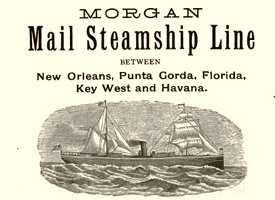
Forty Hours on Southern Seas to the Beautiful Island of Winter Rest
To Cuba via The Palace Steamer PRINCE ARTHUR Plying between NEW ORLEANS and HAVANA
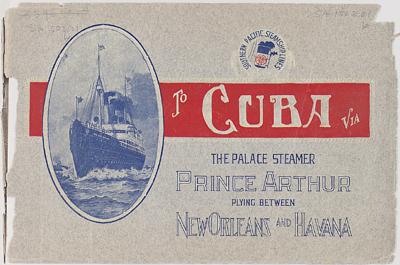 Travel between New Orleans and Havana has grown to such proportions within the last years that it has been impossible to provide accommodations for all those who desired to take the trip, but at last this question has been solved. The Southern Pacific has chartered from the Dominion Atlactic Railway Company the magnificent twin-screw steamship, Prince Arthur, recently plying between New York and Yarmouth. This vessel will be placed in the New Orleans-Havana service and will make her initial trip on October 25, sailing from New Orleans every Wednesday afternoon, arriving at Havana the following Friday morning for breakfast. Returning, steamer will leave Havana on Saturdays at 4 P. M., arriving at New Orleans the following Monday noon. There does not ply in the Gulf of Mexico or on the Atlantic Coast a more seaworthy, comfortable and speedy steamship than the Prince Arthur. This elegant passenger carrier was built in Hull, England, in 1899, especially for the transportation of tourists, and is laid down on the lines of modern trans-Atlantic liners. Her steel hull is
Travel between New Orleans and Havana has grown to such proportions within the last years that it has been impossible to provide accommodations for all those who desired to take the trip, but at last this question has been solved. The Southern Pacific has chartered from the Dominion Atlactic Railway Company the magnificent twin-screw steamship, Prince Arthur, recently plying between New York and Yarmouth. This vessel will be placed in the New Orleans-Havana service and will make her initial trip on October 25, sailing from New Orleans every Wednesday afternoon, arriving at Havana the following Friday morning for breakfast. Returning, steamer will leave Havana on Saturdays at 4 P. M., arriving at New Orleans the following Monday noon. There does not ply in the Gulf of Mexico or on the Atlantic Coast a more seaworthy, comfortable and speedy steamship than the Prince Arthur. This elegant passenger carrier was built in Hull, England, in 1899, especially for the transportation of tourists, and is laid down on the lines of modern trans-Atlantic liners. Her steel hull is 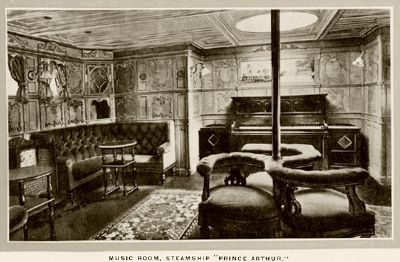 of the yacht model and is fitted with bilge keels, imparting great steadiness of motion. The Prince Arthur is 304 feet long, 39 foot beam and of 2,240 gross tons and has accommodation for 183 first class passengers, 40 second class and 24 steerage.
of the yacht model and is fitted with bilge keels, imparting great steadiness of motion. The Prince Arthur is 304 feet long, 39 foot beam and of 2,240 gross tons and has accommodation for 183 first class passengers, 40 second class and 24 steerage.
…………………………………….
The sailing time of this Steamer will be as regular as the sun. Every Wednesday afternoon she will cast off her lines, turn her head down the stream and begin her 610 mile journey to Havana, leaving the lower horn of the Crescent City dwindling in the distance and glide swiftly down the broad Mississippi, pass the low lying sugar cane, rice, orange and cotton plantations, with their white pillared and deep galleried old Southern homes, surrounded by moss covered oaks and the negro quarters a short distance away, looking like a small village, and by night-fall has passed through the jetties of South Pass and shortly is tossing the foam of the blue-green Gulf of Mexico from her bows. The voyage continues for a night, day and another night of delightful sailing “o’er summer seas.” The day following the departure, Thursday, will be one of quite enjoyment, devoted to social intercourse, watching the passing ships, porpoises and flying fish, and to experiencing the invigoration of the bracing sea air. At early dawn of Friday the dim house of grim old Morro Castle looms in the distance and stands high on the peak of that rocky fortress, a challenging sentinel, once a war-like but now a peaceful guardian. If you rise early you may see the bright constellation of the Southern Cross, and as the high peaks of Cuban mountains begin to peep above the Southern horizon the picture is entrancing. The narrow entrance to the harbor of Havana is between Morro Castle and La Punta, the ship passing close under the gray walls of the old fortress. One hardly knows on which side to look, it is all so interesting.
fish, and to experiencing the invigoration of the bracing sea air. At early dawn of Friday the dim house of grim old Morro Castle looms in the distance and stands high on the peak of that rocky fortress, a challenging sentinel, once a war-like but now a peaceful guardian. If you rise early you may see the bright constellation of the Southern Cross, and as the high peaks of Cuban mountains begin to peep above the Southern horizon the picture is entrancing. The narrow entrance to the harbor of Havana is between Morro Castle and La Punta, the ship passing close under the gray walls of the old fortress. One hardly knows on which side to look, it is all so interesting.
La Punta and the city on the right, Morro and Cabanas on the left, and in the far background the blue hills.
Further up the harbor the little city of Regla is on the eastern shore and on the west is Havana. The harbor is alive with craft, and we see the steam lighter on which the landing will be made from the Prince Arthur. The voyage is over, the tender is waiting to convey passengers from the steamer to the landing at Machina Wharf. Representatives of the express companies meet each incoming steamer; they speak both Spanish and English and will attend to the landing of the passenger’s bagagge, passing it through the Custom House, and its delivery to the hotel with the Cuban and Pan American Express Company. No trouble need be experienced with the Custom service, as the passengers will always find polite employees in that department.
Of all regions that display their winter charms to the tourists and rest-seekers, none combine so many admirable features as does the Isle of Cuba, the “Gem of the Antilles.” The land of beautiful women, brave men and noble deeds, the most beautiful island the sun ever shown upon, is full of interest, romance and tradition.
One must seek far to find a country whose climate is so even, whose scenary is so picturesque, whose people are so hospitable and whose history is so interesting.
The very name of this favored West Indian Island has become a synonym for the ideal land of Winter rest. Its features are pastoral in their loveliness. Groves of banana and orange trees dot the valleys and hillsides, while the stubby coffee 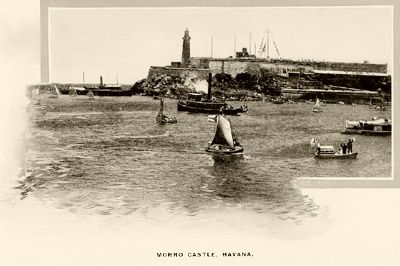 shrub adorns the slopes of the mountains, and constantly affords a growing source of wealth. Tobacco plantations and sugar states, the latter of gigantic proportions, give the cultivated areas and appearance of wonderful richness and fertility, while the great mills add their quota of material to industry and progress.
shrub adorns the slopes of the mountains, and constantly affords a growing source of wealth. Tobacco plantations and sugar states, the latter of gigantic proportions, give the cultivated areas and appearance of wonderful richness and fertility, while the great mills add their quota of material to industry and progress.
A trip through any portion of the Island is replete with interest, and in the field of forest the eye falls upon things foreign to the resident of our own country and in consequence thereof, of extraordinary attractiveness. To many Cuba has been only the scenes of romantic novels, the memory of a geography lesson, and to travelers a far country that few ever reach, but those who did went their way there always remembered it, the subject of many fascinating reminiscences told to the listeners at home, holding them entranced. One who comes within its sea-washed borders for the first time, knows only that he has never before in a country like it, and never ceases to marvel. Although it has always laid right at the door of the United States, it has never gained the publicity it deserves. In point of fact, it is only within the last few years that the people of the United States, in any considerable numbers, have found their way to this beautiful island. The natural beauty of the country is unsurpassed, and one may travel for miles in the island through the uncultivated country, where wild oranges groves, banana orchards, tall and stately cocoanut palms, and flowers of every variety and hue abound. It appears as one vast park trained under the most skillful touch of the florist.
A trip to Cuba cannot be excelled for pleasure, profit and cheapness by any trip in the world.
New Orleans
Here behold you, in a floral profusion, unrivaled in the continent, the products of both the Tropic and Temperate Zones.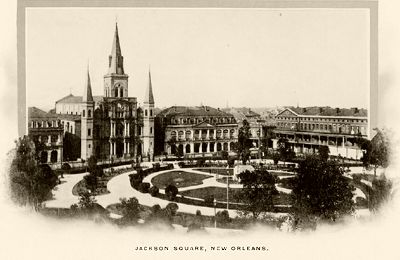 Here, in the quaint, high-walled French quarter, we have the Old World, and in the sky-scrapers and modern villas up town, the New. Here mingle, in one advancing community, the forceful but impassive Anglo-Saxon character, and the warm, impulsive and romantic Latin type. Decidedly a city of contrasts, this New Orleans! And this is the fact that gives it, to the stranger, much
Here, in the quaint, high-walled French quarter, we have the Old World, and in the sky-scrapers and modern villas up town, the New. Here mingle, in one advancing community, the forceful but impassive Anglo-Saxon character, and the warm, impulsive and romantic Latin type. Decidedly a city of contrasts, this New Orleans! And this is the fact that gives it, to the stranger, much 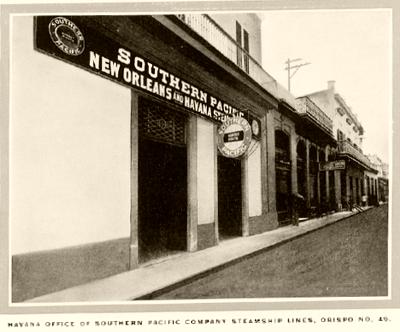 of its singular and insistent attraction and charm. What city, indeed, is like it, this chief city and center, seat and capital, so to speak, of the life, the pleasure and business of the prosperous and progressive Gulf region of the South? What other city of the country afford such antitheses? Where else will you find the old and the new, antique and modern, examples of yesterday and of to-day, face to face and side by side? And not alone in architectural and superficial aspects, though most apparent possibly therein, but in the manners and customs, the ideas and ideals of its various peoples and elements.
of its singular and insistent attraction and charm. What city, indeed, is like it, this chief city and center, seat and capital, so to speak, of the life, the pleasure and business of the prosperous and progressive Gulf region of the South? What other city of the country afford such antitheses? Where else will you find the old and the new, antique and modern, examples of yesterday and of to-day, face to face and side by side? And not alone in architectural and superficial aspects, though most apparent possibly therein, but in the manners and customs, the ideas and ideals of its various peoples and elements.
…………………………………………….
But now New Orleans links with its traditions of chivalry and hospitality, and to the romance of its history, all the spirit and enterprise that modern methods and accumulating wealth hold forth as an incentive to progress in industry and comfort in living. It will be more potent in the years to come than it has been in the past, for it appeals both to the investor, the man of affairs who has de foresight to see its expanding opportunities of wealth-getting, and to the pleasure-seeker of the North who flies to it to discover in its cosmopolitan life and Latin graces the relaxation he needs, and finds here, too, the invigoration of a climate as seductive as the shores of the Medierranean.
………………………………………………
Forty Hours on Southern Seas to the Beautiful Island of Winter Rest. [Houston?]: Southern Pacific Steamship Lines, 1905.
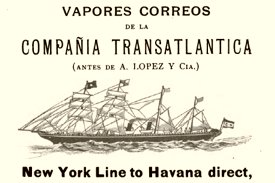
Fanny Elssler at the Havanah
The following letters, although not the productions of the pen of Mdlle. Fanny Elssler, nevertheless contain in a translated form her impressions and the incidents of her visit to the Havanah. In some susequent numbers of REGINA other letters will appear, and will probably, with still further abstracts, which will not be inserted in this Magazine, be published in the form of two or three volumes. We feel assured that the gay, witty, playful papers, of which a specimen is now laid before our readers, will be perused with delight by all the admirers of Mademoiselle Fanny, and will attract for them the attention they so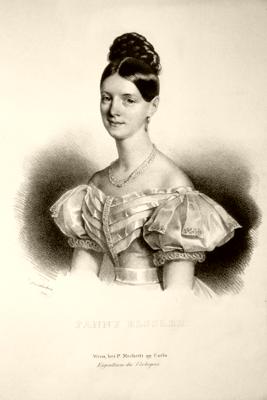 abundantly deserve. It is, of course, generally known that after years of unparalleled success in all the national theatres of Europe, this Queen of “Danseuses” was prevailed on to proceed to America. In the letters which we have submitted to our readers in this month’s REGINA, we find her impressions of sunny lands and of a far different life to that of London or Paris portrayed with a delicacy and finesse which accord with the mind and character of this universal favourite. “Fanny Elssler in Paris” will form the subject of the next article which will appear in this Magazine in January.
abundantly deserve. It is, of course, generally known that after years of unparalleled success in all the national theatres of Europe, this Queen of “Danseuses” was prevailed on to proceed to America. In the letters which we have submitted to our readers in this month’s REGINA, we find her impressions of sunny lands and of a far different life to that of London or Paris portrayed with a delicacy and finesse which accord with the mind and character of this universal favourite. “Fanny Elssler in Paris” will form the subject of the next article which will appear in this Magazine in January.
Havanah, January 1841
DEAR MINA, -- You wonder, and not without reason, at all my odd adventures, amusing good fortune, and strange wanderings, but not more than I do myself. I live and move in an atmosphere so brilliant and stimulating, that I am quite lost and unconscious of the reality of things. My senses are stepped in a sort of eddy of intoxication, till drowning seems inevitable; but before I am quite gone, let make one effort to give you some account of my late travels, and that in as sober a manner as I can. Well, then, I left Charleston on the 3d instant, and committed myself with trembling apprehensions to the queer little boar they called a schooner, destined to bring us here. […] There were several Americans making their annual pilgrimage to Cuba, where they spend their winters engaged in commercial pursuits, and return when pestilence warns them away. There was one fellow-passenger who attracted my attention by his solitary ways and silent habits; no one knew him, and he avoided acquaitance with all. He came to table, ate, spoke not, and retired. He spent hours gazing at the sea, and reading the rest of the day. He never talked with, and even never looked at, any one. The mysterious man in black made me very anxious to know who he could be. I conjectured, as all did at last, a thousand things; but the voyage finished and he departed, without giving token of where he came from or whiter he was bound. […]
…………………………
A more sunny, smiling day than the 14th of January, 1841, never lit up this blessed world. I had risen early, full of 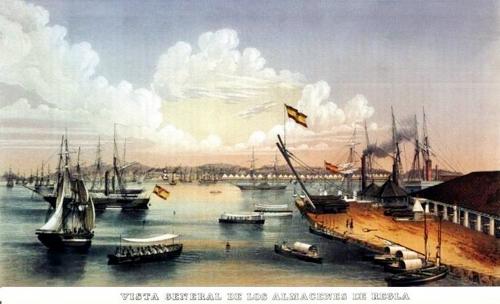 longing and expectation. We were in sight of land at seven A. M., and we neared rapidly. At nine I could easily distinguish objects and the first one I could clearly discern interested me greatly; it was a noble fortress commanding the entrance to the harbour, and called the Moro Castle. It has a yellow, mellow tint, that belongs to this delicious clime, and its rocky foundations had a look so firm and strong, as though they laughed to scorn the impotent waves dashing against its base. There were several picturesquely dressed people sitting at various parts fishing as we swept by, which gave it an additional pleasant effect, and our vessel turned sharply round it, and with such dexterous quickness as though it remembered its well-known course, and what a sight broke upon me with all the suddenness of magic! How magnificent and how indescribable! I stood transfixed in wonder and delight. Before me lay the harbour, beautiful in shape, and its fine quays thickly lined with hundreds of vessels of all nations. […] Great masses of iddle people were standing contemplating our arrival, the vessels teeming with negroes, oddly attired, were at work rolling cargoes in and out, and accompanying their labour with a lively chaunt, both musical and strange. […] I had been recommended to a well-known hotel, called West’s, and that person, a tall, stout man, with a sharp, knowing look, now advanced, saying he had reserved appartments, &c., and requested our passports that he might get a “permit to land.” In half-an-hour, however, we got on
longing and expectation. We were in sight of land at seven A. M., and we neared rapidly. At nine I could easily distinguish objects and the first one I could clearly discern interested me greatly; it was a noble fortress commanding the entrance to the harbour, and called the Moro Castle. It has a yellow, mellow tint, that belongs to this delicious clime, and its rocky foundations had a look so firm and strong, as though they laughed to scorn the impotent waves dashing against its base. There were several picturesquely dressed people sitting at various parts fishing as we swept by, which gave it an additional pleasant effect, and our vessel turned sharply round it, and with such dexterous quickness as though it remembered its well-known course, and what a sight broke upon me with all the suddenness of magic! How magnificent and how indescribable! I stood transfixed in wonder and delight. Before me lay the harbour, beautiful in shape, and its fine quays thickly lined with hundreds of vessels of all nations. […] Great masses of iddle people were standing contemplating our arrival, the vessels teeming with negroes, oddly attired, were at work rolling cargoes in and out, and accompanying their labour with a lively chaunt, both musical and strange. […] I had been recommended to a well-known hotel, called West’s, and that person, a tall, stout man, with a sharp, knowing look, now advanced, saying he had reserved appartments, &c., and requested our passports that he might get a “permit to land.” In half-an-hour, however, we got on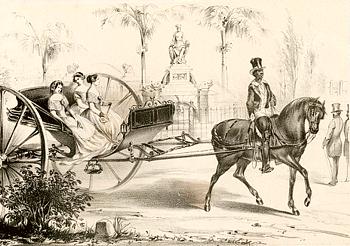 shore near the Custom House. I looked in as I passed and was vastly amused with the noisy scene of confusion it presented; filled chiefly with negroes most grotesquely costumed, and capering among the boxes and bales, like so many full-grown baboons: but the din, the uproar, singing and yelling, beggared description, and made retreat soon necessary. I was conducted to a volante provided for our transit to the hotel; and was ever seen such a vehicle before? the oddest, drollest thing imaginable! What a sensation it would make in the Champs
shore near the Custom House. I looked in as I passed and was vastly amused with the noisy scene of confusion it presented; filled chiefly with negroes most grotesquely costumed, and capering among the boxes and bales, like so many full-grown baboons: but the din, the uproar, singing and yelling, beggared description, and made retreat soon necessary. I was conducted to a volante provided for our transit to the hotel; and was ever seen such a vehicle before? the oddest, drollest thing imaginable! What a sensation it would make in the Champs 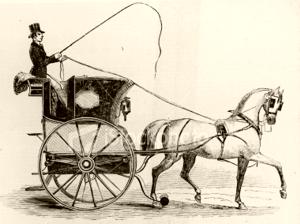 Elysées. I will send you a picture of one, for you can never realize it by any description of mine. It is something like a London gentleman’s cabriolet, but hanging very low; and then such wheels, more than six feet in height, and the shafts in proportion. The horse, or mule more frequently, is harnessed almost at end of them, so that the poor animal turns round a corner without your dreaming he is attached to any thing, but directly comes in sight the ponderous volante. […] We got in, and started under the auspices of Mr. West, and after several turnings through narrow streets, but clean and pretty, we arrived at our destination. We entered a high porte cochére, reminding me of the Parisian entrances, and, ascending a fine broad staircase, were ushered into the “apartment.” This was the first shock I experienced, and it was a strong one, I assure you: quite a galvanic battery. The saloon, so called, was low and unprepared; there was a tile floor, scantily furnished with flimsy materials; with one window, and that decorated with iron bars, giving a very cage-like aspect to the place; and, more than all, it was quite dark, by reason of the shadow of a tall house erected opposite. The bedroom I reached bycrossing a sort of viaduct, and found it small and uncomfortable; after the spacious and elegant hotels in the United States, I found such lodgings doubly offensive. […] As a matter of favour, we had our meals served in our saloon, for the custom is to meet at table d’hôte, which I declined, of course, for being regarded as sort of a lion or lioness, I did not care to be watched while feeding. I learned this occasioned a good deal of dessapointment, as several curious persons, not living in the hotel, had secured places at the table to get a look at the “new arrival.” Let these gastronomic enthusiasts come to the theatre, and welcome. [….]
Elysées. I will send you a picture of one, for you can never realize it by any description of mine. It is something like a London gentleman’s cabriolet, but hanging very low; and then such wheels, more than six feet in height, and the shafts in proportion. The horse, or mule more frequently, is harnessed almost at end of them, so that the poor animal turns round a corner without your dreaming he is attached to any thing, but directly comes in sight the ponderous volante. […] We got in, and started under the auspices of Mr. West, and after several turnings through narrow streets, but clean and pretty, we arrived at our destination. We entered a high porte cochére, reminding me of the Parisian entrances, and, ascending a fine broad staircase, were ushered into the “apartment.” This was the first shock I experienced, and it was a strong one, I assure you: quite a galvanic battery. The saloon, so called, was low and unprepared; there was a tile floor, scantily furnished with flimsy materials; with one window, and that decorated with iron bars, giving a very cage-like aspect to the place; and, more than all, it was quite dark, by reason of the shadow of a tall house erected opposite. The bedroom I reached bycrossing a sort of viaduct, and found it small and uncomfortable; after the spacious and elegant hotels in the United States, I found such lodgings doubly offensive. […] As a matter of favour, we had our meals served in our saloon, for the custom is to meet at table d’hôte, which I declined, of course, for being regarded as sort of a lion or lioness, I did not care to be watched while feeding. I learned this occasioned a good deal of dessapointment, as several curious persons, not living in the hotel, had secured places at the table to get a look at the “new arrival.” Let these gastronomic enthusiasts come to the theatre, and welcome. [….]
……………………………….
Havanah, January 1841
[…] I sent no notice of my arrival to the sole manager of the theatres, Don Francisco Martí, nor meant to have delivered a single letter, but policy forced me to do so at an early moment. You shall hear now. The day after my landing, and whilst anxious to know the result of my irregular proceeding, a message was brought in to the effect that Don Marti, the autocrat of all theatres, would like to see me. “Faites l’entrée,” I said, and immediately there came in the oddest-looking creature imaginable. Neither tall nor thin exactly; loose white trousers dangling on his legs, with an ill-shapen black coat thrown over his shoulders; white cravat, and a great pin stuck in his shirt; his hair was tossed over on one side, and a woman’s side-comb secured it; the face was colourless and wrinkled, and expressed great cunning. […] He talked a droll mixture of French and Spanish, which made me laugh in spite of myself. He said he would like to engage me for five or six nights, but then the difficulty to get those nights. He had his Spanish company performing at one theatre, his Italian company at another, and he could not think of disturbing their function, as he styled their representations. After a great deal of calculation and writing down about nights he came to the point, and wanted to know my terms. I discovered immediately in Don Marti over-acuteness and great closeness; he had tried to frighten me with the uncertainty of my appearing at all, and was bent on getting me cheap; so I thought I would astonish him at once; and with great demureness I stated that I would accept 1000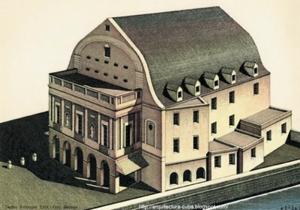 dollars per night, a benefit for myself, a half benefit for my maître de ballet, and some allowance for expenses of the three artistes I brought with me. Don Marti, upon hearing this, looked at me to see if I was in earnest, then drew a long breath, put on his hat that he fitted tightly, and without saying a word, took his departure. […]
dollars per night, a benefit for myself, a half benefit for my maître de ballet, and some allowance for expenses of the three artistes I brought with me. Don Marti, upon hearing this, looked at me to see if I was in earnest, then drew a long breath, put on his hat that he fitted tightly, and without saying a word, took his departure. […]
…………………………..
I went first to the Italian Opera given in the Teatro Principal, the oldest of the two theatres in Havanah. There is a third building devoted to dramatic purposes by an amateur company, but small and ill-constructed. But the Teatro Principal and Tacon are first-class edifices, and worthy especial notice. The former stands within the walls of the town, near the top of the harbour, and is well and conveniently situated. It has small pretensions to architectural beauty of any kind, and perfectly plain in style, and without ornament. The entrance is by two small doors under an archway, which open into a narrow corridor, with stairs to the right and left leading to the boxes. 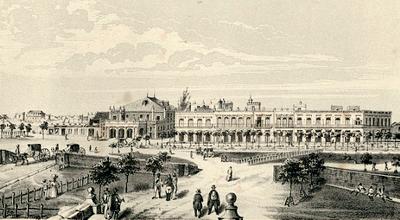 There is a ground-tier, also, enclosing the pit of very good size, divided in rows of seats, each one covered with red morocco, with arms and back, and numbered. Nothing can be more convenient and comfortable. These places are called lunettas, and are let at moderate prices for the night or for the season. So are the boxes, except those belonging permanently to several great families. In all, there are four tiers of boxes. The house is lofty,
There is a ground-tier, also, enclosing the pit of very good size, divided in rows of seats, each one covered with red morocco, with arms and back, and numbered. Nothing can be more convenient and comfortable. These places are called lunettas, and are let at moderate prices for the night or for the season. So are the boxes, except those belonging permanently to several great families. In all, there are four tiers of boxes. The house is lofty,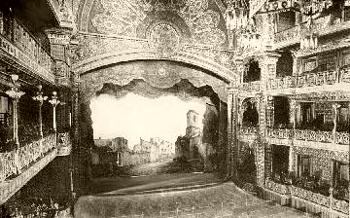 well-proportioned, and neatly decorated; the stage of ordinary size, and the scenery good; the orchestra strong, upwards of thirty performers in number, and of all colours, white, black, and yellow – a bit of mosaic armoniously composed. Their performances are generally correct and effective. […] The company now here is very good, including several artists of very superior merit. The opera on this occasion was the well-known Norma, and I greeted it as an old friend. […]
well-proportioned, and neatly decorated; the stage of ordinary size, and the scenery good; the orchestra strong, upwards of thirty performers in number, and of all colours, white, black, and yellow – a bit of mosaic armoniously composed. Their performances are generally correct and effective. […] The company now here is very good, including several artists of very superior merit. The opera on this occasion was the well-known Norma, and I greeted it as an old friend. […]
………………………………
[…] By dint of persuasion and authority, Don Marti has forced some of his female subordinates of the theatre into the ranks; but they are the most unpromising material that ballet-master ever worked upon. They are willing enough, poor things; but 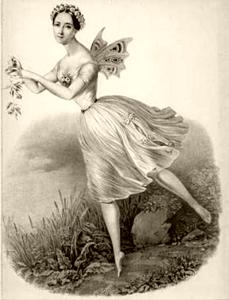 Nature never contemplated such a destiny for them, and has made them accordingly. Fat, ill-shapen, clumsy, and heavy, how can they ever be transformed into “sylphides”? Sylvain is persevering, but not conjuror; and such a miracle is not reserved for our days. And, then, their colour, so dark and swarthy, how can they be improved without scraping their faces? Just conceive of a winged fair of the Opera House, as radiantly white as pearl powder and gauze can make her, being personified by a plump mulatto, yellow as saffron, and as incapable of a f[?] of activity as a super[?] cow, and about as beautiful. I am greatly distressed to see this fine ballet of La Sylphide getting up for my début, marred in this lamentable way; yet I cannot help being entertained by this novel treat. I wonder how the public will take it? They must be good-natured, indeed, if not offended or annoyed by the sorry spectacle preparing. It may quite ruin me, for the ludicrous is a dreadful foe to contend with; and the weddling of these brown sprites may confound all my attempts at grace. Nous verrons. The prices have been inordinately raised; but quite half the places are already sold for the whole engagement. This promises well, and Marti is likely to be a great winner; for his Theatre Tacon, where I am to dance, is the largest, and he is the sole owner. It stands just outside the walls, and looks on the Paseo, or public promenade. It has a fine portico of stone stuccoed, but separated from the main building by a courtyard, into which
Nature never contemplated such a destiny for them, and has made them accordingly. Fat, ill-shapen, clumsy, and heavy, how can they ever be transformed into “sylphides”? Sylvain is persevering, but not conjuror; and such a miracle is not reserved for our days. And, then, their colour, so dark and swarthy, how can they be improved without scraping their faces? Just conceive of a winged fair of the Opera House, as radiantly white as pearl powder and gauze can make her, being personified by a plump mulatto, yellow as saffron, and as incapable of a f[?] of activity as a super[?] cow, and about as beautiful. I am greatly distressed to see this fine ballet of La Sylphide getting up for my début, marred in this lamentable way; yet I cannot help being entertained by this novel treat. I wonder how the public will take it? They must be good-natured, indeed, if not offended or annoyed by the sorry spectacle preparing. It may quite ruin me, for the ludicrous is a dreadful foe to contend with; and the weddling of these brown sprites may confound all my attempts at grace. Nous verrons. The prices have been inordinately raised; but quite half the places are already sold for the whole engagement. This promises well, and Marti is likely to be a great winner; for his Theatre Tacon, where I am to dance, is the largest, and he is the sole owner. It stands just outside the walls, and looks on the Paseo, or public promenade. It has a fine portico of stone stuccoed, but separated from the main building by a courtyard, into which 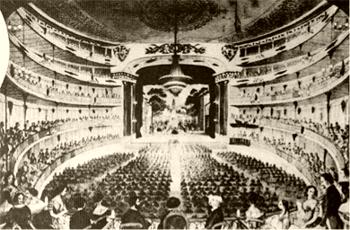 carriages drive, letting down at the doors, three in number, opening on the ground tier. The interior is most striking; the size is very great, hardly surpassed by San Carlos or La Scala, and far more elegant in proportions and style. The tiers are five; but the first tier, instead of being panelled in, as usual, is adorned by a graceful iron railing, surmounted by a mahagony top bannister, with small gilt knobs. The effect is singularly pleasant and new. The boxes are divided from each other, as in the Teatro Principal, by thin proportions of three feet in height, allowing full view and conversations between neighbors; and are provided with chairs, four or six, and varying proportionately in price. It is lighted by an immense chandelier hanging in the centre with oil-lamps; but they give a strong and sufficient light to all parts of the house, which, being painted chiefly in white, reflects it back again. I should observe en pasant, there are two places set apart for official dignitaries of the fighest standing.
carriages drive, letting down at the doors, three in number, opening on the ground tier. The interior is most striking; the size is very great, hardly surpassed by San Carlos or La Scala, and far more elegant in proportions and style. The tiers are five; but the first tier, instead of being panelled in, as usual, is adorned by a graceful iron railing, surmounted by a mahagony top bannister, with small gilt knobs. The effect is singularly pleasant and new. The boxes are divided from each other, as in the Teatro Principal, by thin proportions of three feet in height, allowing full view and conversations between neighbors; and are provided with chairs, four or six, and varying proportionately in price. It is lighted by an immense chandelier hanging in the centre with oil-lamps; but they give a strong and sufficient light to all parts of the house, which, being painted chiefly in white, reflects it back again. I should observe en pasant, there are two places set apart for official dignitaries of the fighest standing.
………………………………………………..
Fraser’s Magazine, no. CLXVIII, December 1843, Vol. XXVIII, 713-728.

